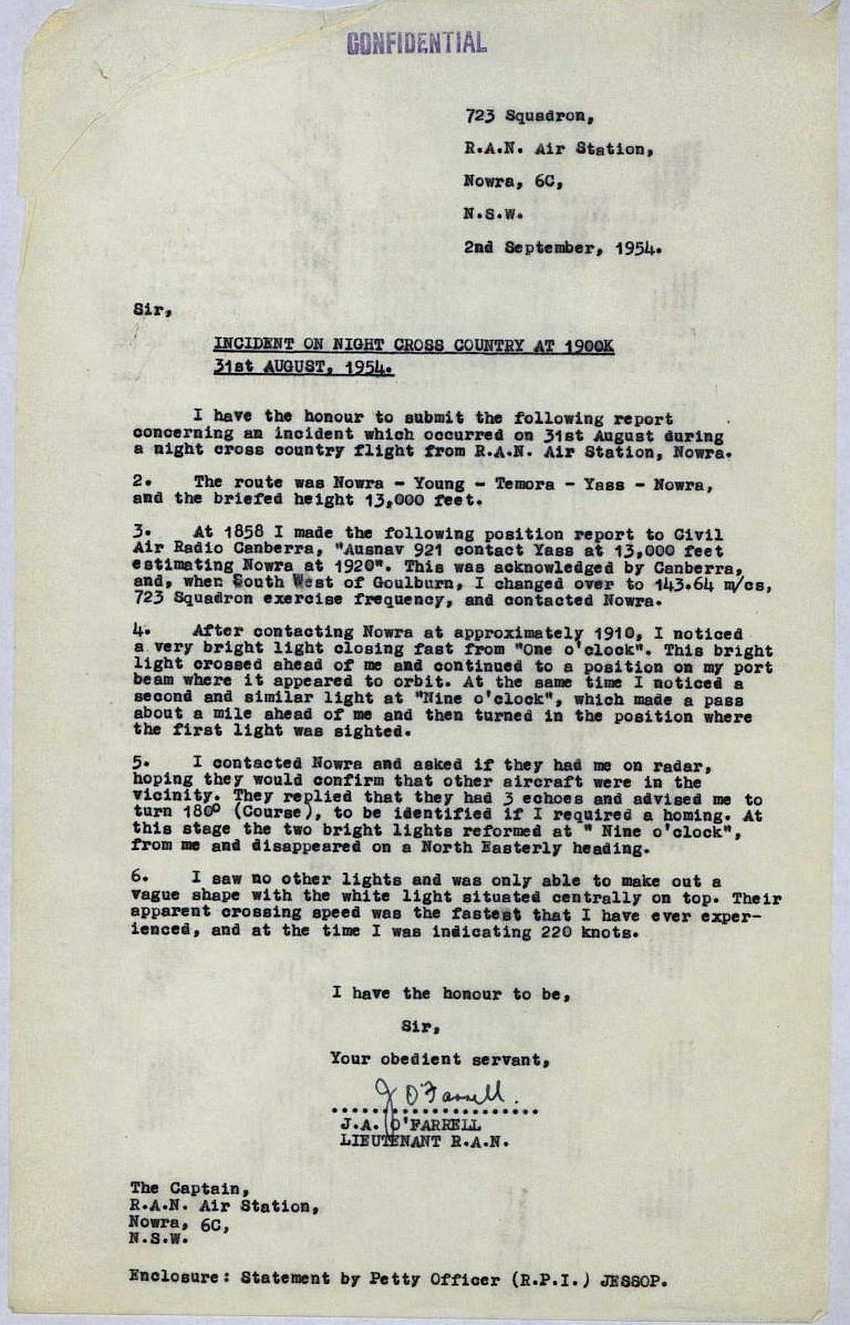
Section 1 - INTRODUCTION
One of the most fascinating and controversial Australian radar/visual sighting reports involving unidentified flying objects, occurred on August 31, 1954. This fascinating story was leaked to the media in December 1954 and made headlines across Australia.
The incident involved a young naval pilot, Lt. Shamus O'Farrell, 25 years old at the time, who was returning to the Royal Australian Naval Air Station Nowra in New South Wales, after a lone night mission exercise, in a Sea Fury aircraft. After contacting Nowra at approximately 1910hrs, O'Farrell observed a very bright light closing fast at 1 o'clock, which crossed in front of his aircraft, moving to his port side, where it appeared to orbit. A second similar light was observed at his 9 o'clock position. It passed at approximately 2.5km in front of his aircraft and then turned in the position where the first light was observed.
According to O'Farrell, the apparent crossing speeds of the two lights were the fastest he had ever encountered. At the time he had been flying at 220 knots. O'Farrell then contacted Nowra, who confirmed that there were two ‘paints’ in company with him. The radar operator, Petty Officer Keith Jessop, confirmed the presence of two objects near the Sea Fury on the G.C.I remote display. The two lights reformed at nine o'clock and then disappeared on a north-easterly heading. O'Farrell could only make out a ‘vague shape with the bright light situated centrally on top.’
The Directorate of Naval Intelligence, at the time, wrote that ‘Shamus O'Farrell was an entirely credible witness’ and that he was visibly ‘shaken’ by his experience, but remains adamant that he saw these objects.
I have known about this incident since I read Bill Chalker's book ‘The OZ Files’ back in 1996. It is a fascinating case that ticks all the boxes. A qualified and experienced Naval pilot; confirmation from the ground radar operator from the Nowra Naval Air-Station, and the possibility of two independent ground witnesses, who confirmed seeing the presence of two bright lights. To this day, no real explanation has been found to explain this incident and is considered one of the best UFO/radar encounters to date.
This is one of the true UFO mysteries, that I feel needs to be explored in detail.
Bill Chalker was one of the first civilian UFO researchers to study the cold case, and bring it to the public's attention, although a book published in 1991 by Ken Llewelyn titled ‘Incredible True Stories of Airmen on Earth Plane and Beyond’ was cited as an authoritative source of the Nowra Radar incident. Ken Llewelyn was a senior Public Relations Officer with the RAAF. Bill Chalker wrote about the incident in his book, ‘The OZ Files’ in 1996. Since then Bill Chalker has written a number of articles on-line that have been copied and pasted by numerous UFO websites. In 1993 Bill Chalker assisted ‘The Extraordinary’ TV program with the recreation of the Sea Fury incident. Shamus O'Farrell, Keith Jessop and Bill Chalker were interviewed for the program. (Available on YouTube - ‘The Extraordinary E04’.)
Very little has been done since the 1990s concerning this intriguing cold case. The only other researcher to look at the Nowra cold case, has been Keith Basterfield in 2012. He has been examining classic UFO cold cases for a number of years. During the Disclosure Project (Australian UFO Research Association, 2003-2008) Keith found two original 1954 files on the Nowra Incident in the National Archives of Australia. On these files were copies of the original written reports on the incident, from the pilot and the radar operator. This was an exceptional primary source that verified the incident as a credible sighting. Although sadly, the Joint Intelligence Bureau investigation files have not been seen since 1973 and have never been sighted by civilian researchers. Whether they have been destroyed or just misfiled is anyone's guess, although Keith Basterfield is still trying to find the missing files. As Keith Basterfield said in his blog, ‘The key to further research on this case appears to lie with the possible locating of the missing files.’
As with all my cold case research papers, I will go back to the original sources, that include reports; new paper articles, and show how this cold case has stood the test of time. I will also introduce my hypothesis from the available data.
Section 2 - ORIGINAL NEWSPAPER CLIPPINGS CONCERNING THE SEA FURY RADAR INCIDENT
Herald (Melbourne) Wednesday, 15th December 1954
NOWRA, Today - Two objects believed to be flying saucers have been recorded by radar at Nowra Naval Air Station.
This was revealed when the Minister for the Navy, Mr. Francis visited the station today. A naval pilot flying a single seater fighter from Canberra to Nowra just after dark a few days ago was joined in the air by two strange aircraft resembling saucers.
He called Nowra air control to trace him by radar. Nowra reported that the radar screen showed three aircraft flying together.
The Naval pilot identified himself by executing movements in accordance with directions from Nowra.
He later reported that the two unidentified objects which flew in company with him for some time were much faster than his Sea Fury fighter.
His account of the subsequent movement of the mysterious machines was fully corroborated by radar records at Nowra.
No other planes fast enough to keep company with a Sea Fury were known to be in the area at the time.
The identity of the mysterious machines has not been discovered.
The Sun (Melbourne), Thursday 16th December 1954
Two ‘flying saucers’ have been recorded by (NSW) naval air station.
Naval Officers at Canberra and Nowra confirmed this last night.
They said that the ‘saucers’ flew alongside a Navy fighter plane and were tracked on the radar screen before disappearing.
The ‘saucers’ identity is still a mystery. In Brisbane last night, the Minister for Navy, Mr. Francis said: ‘This matter has not been mentioned to me. I will order an immediate investigation. The saucers appeared three months ago when a navy pilot was flying a single-seater fighter from Canberra to Nowra. Just after dark the pilot saw two strange aircraft flying nearby. He told Nowra air control about the mystery objects.
Then three aircraft flying together showed up on the radar screen.
Nowra directed the pilot to execute certain movements to identify himself.
He did so and the saucers gradually drew away and vanished.
All the movements were confirmed on the radar screen.
In Canberra, last night senior Air Force officers warned that ‘flying saucers’ were likely to be reported in the next few weeks.
They said that these would be guided aircraft and projectiles.
But they refused to confirm or deny that experiments had been made with these projectiles on the coast.
Herald (Melbourne), Thursday 16th December 1954
Sydney, Today. - Naval authorities admitted today that they cannot find any ‘human source’ for the ‘flying saucers’ recorded on a radar screen at Nowra.
At the same time that the saucers were seen on the screen a Sea Fury pilot reported saucer shapes flashing past him.
Authorities have confirmed that the pilot was ‘a man of experience’. They said they had investigated ‘every human source’ but could not logically explain the shapes. The mystery of the shapes is locked away in Naval Files.
Professor Messell of Sydney University said today that flying saucers seemed to be a top secret military experiment.
‘No one is stupid enough to believe they come from outer space but they could be a military development’.
‘There have been so many reports from ordinary people that there could be something in them.’ In WASHINGTON, President Eisenhower said today that United States Air Force official had told him that flying saucers did not come from outer space.
The President said this at a Press conference. He did not say whether he thought flying saucers existed.
Argus (Melbourne), Friday 17th, December 1954
Canberra, Thursday
Mr. Francis, Navy Minister, tonight confirmed the sensational ‘flying saucers’ report by Royal Australian Navy Pilot in the Argus yesterday.
Mr. Francis said: ‘It is a fact that on a night cross-country flight from Nowra on August 31, at 13,000 feet above Goulburn, a pilot in a Sea Fury observed two lights on his radar, with vague shapes underneath.’
The lights passed ahead of him at a very fast speed as he flew at 220 knots (just under 250mph). The pilot made contact with Nowra and advised them.
It was later ascertained that the only other aircraft in the vicinity was a TAA Convair.
‘This was passed by Naval Intelligence to RAAF Intelligence’ said Mr. Francis. The pilot is believed to be Lieutenant O'Farrell, formally from Sydney, now stationed at Nowra.
Experienced Naval airmen at Nowra discount the possibility that the shapes were unidentified aircraft.
Herald (Melbourne), Thursday 16th December 1954
Canberra, today, The naval pilot who was ‘buzzed’ by two ‘flying saucers’ is believed to be Lieutenant R. O'Farrell, of Sydney. But the authorities have not officially revealed the pilot’s name.
This is part of the hush-hush surrounding the three-month-old saucer incident.
This hush-hush means that either the incident is not being treated seriously or it’s under investigation.
But officers at Nowra NSW, Naval Air Station where the saucers were tracked on a radar screen are certain that two ‘objects’ were near the pilot.
This is a clear case in which ‘objects’ have been independently recorded from the radar screen agreed exactly with the pilot’s report.
The pilot, fearing that he might be ‘ragged’ in the wardroom on his return if he abruptly reported flying saucers, called Nowra by radio and asked whether the radar screen showed his aircraft. He gave his position.
Nowra asked him to manoeuvre so that he could be identified. He did, and got a reply identifying his position.
When he returned to base his account of the movement of the two objects agreed with radar report. Naval authorities admitted today that they could not find any ‘human’ source to the objects.
Argus (Melbourne), Thursday, 16th December 1954
Official report NAVY SAW 'SAUCERS' IN N.S.W
Two ‘flying saucers’ have been reported by a Naval pilot and plotted on radar over Goulburn, 60 miles from Canberra.
The pilot reported he had seen the ‘saucers’ flash past his Sea Fury at supersonic speed.
The Navy report is the first authenticated information in the world of the existence of ‘flying saucers’.
But officials revealed yesterday that the incident occurred three months ago.
A Navy pilot then reported to Nowra Naval Air station that he had seen two unidentified objects overtake his aircraft.
When he saw the objects, he asked the air station radar control to check their screens.
The radar officers then reported back that they could see three objects on their radar screens in including the Sea Fury.
In the pilot’s report, he said he was flying over Goulburn at 15,000 ft when he saw two lighted objects flash by.
He said they easily passed his Sea Fury propeller-driven fighter which was capable of flying at 450 m.p.h.
The pilot reported the incident to Nowra radar officers about 9.30 p.m., and radar officers, after a check, revealed that there were no other aircraft in the vicinity at the time.
Navy pilots at Nowra and senior Navy men declare they are puzzled by the report.
The pilots, many of them with combat experience in Korea, discount the possibility that the two objects could have been unauthorised aircraft.
Continued on page 5
Continued from page 1
In talk among themselves they refer to the ‘flying saucers incident,’ but because of the ‘top secret’ classification of the incident, news of the occurrence has been kept from the public.
Reports of the Goulburn - Nowra incident are believed to have been sent to intelligence and technical branches of all three services.
The report follows similar reports over the past year by service and civilian pilots who have reported strange objects over Melbourne and other eastern Australian areas.
There is now a special order to Navy and RAAF pilots to watch out for unidentified flying objects.
It is believed that a special watch has been instituted on all radar stations in Australia.
(Source for Newspaper articles: National Archives of Australia, file series SP338, control symbol 13/4/10, titled ‘Unidentified Objects (flying saucer reports of).’)
1991
Bill Chalker was the first civilian researcher to investigate the Sea Fury radar incident, but the oldest written material I could find on the incident was through Keith Basterfield’s blog article on the Sea Fury Incident, from 2012, where Keith found a secondary source, a book titled ‘Flight Into the Ages. Incredible True Stories of Air Men on the Earth and Beyond.’ It was published in 1991, by Felspin Pty Ltd of NSW (ISBN 064074911.) The book’s author was Ken Llewelyn, who was a senior Public Relations Officer with the RAAF. Keith reproduced the text on the incident from pages 137-139 of the book:
Flight Into the Ages (pages 137-139)
“First, however, consider the experience of a Royal Australian Navy Pilot on 15 December 1954
Lieutenant Shamus O'Farrell was flying a powerful Sea Fury aircraft on a standard night-navigation exercise from his base at Nowra, 160 kilometres south of Sydney, when he experienced an event which confounded experts in the Department of Defence. Shamus had taken off at dusk and been flying for about two hours. His British-built fighter was powered by a massive eighteen cylinder British Centaurus radial engine and, apart for the RAAF recently introduced Meteors, it was the fastest flying machine in the country, with a top speed of 400 knots.
The incident, which happened at about 8:00pm, is described in the pilots own words, from memory,’ I was just over 12,000ft. It was a fine dark night. The stars were all out with no moon, no clouds, no bad weather and good visibility. A pleasant night for night flying.
I had been airborne for about two hours and was somewhere in the Goulburn region, near Canberra. When I left Nowra, the radar there was not working, but they were hoping to get it on line by the time I returned. The operators asked me to call so that they could do a check-tune on me as I came in. I was surprised when I saw two aircraft, on either side of me, each with a single bright light above it, but with no navigation lights. In fact, it was quite a shock because everything was going well. I was keeping a lookout, constantly scanning from one side of the aircraft to the other. They came from astern and I looked out to one side and thought, ‘Gee, what is that?’ I continued to look around and there, on the other side, was another one. And then I thought about it for some time to make sure I wasn't seeing things that weren't there. But sure enough, I could see two dark cigar-shaped objects - not very long, about the size of a Dakota - but their central bright lights made their outline quite distinct. I could see no other details, no other lights - just one bright centrally placed light over the top of each mass.
‘I became concerned at the presence of these objects and began to think about the situation again: ‘if I say too much they will think I am seeing objects that aren't there, and they will get worried; the best thing to do is to say nothing and just call up Nowra. ‘I asked them, ‘Do you have me on radar? Back came Petty Officer Jessop's reply, Yes, we have an aircraft coming in from the west - in fact we have got three. Which one are you?’ And I replied, I am the one in the centre. ‘And then he said, ‘Fly a one-eighty for identification.’
So, I turned though 180 degrees. ‘Yes, I have got you turning in the centre, ‘He said, I finally finished a 360 degree turn because I lagged behind the other two aircraft, who had continued to move ahead. Then, when I came back up, they settled back into formation with me.
‘I still believe they could be aircraft without their lights on I was expecting to see a red or green light or flashing lights, but each had a steady light. I tried to visualise other unusual combinations of lights which may have created the effect - even landing lights on the underside of an aircraft. But the lights were above the aircraft or whatever they were.
‘Nowra was worried after I called because they had started checking and found out that there were no other aircraft airborne on the east coast. All RAAF aircraft were on the ground and the civil aircraft that had been flying in the region had already landed. I was the only aircraft airborne.
‘Then I started to think, ‘Well, who the hell are they? Because I was cruising about 330 knots and apart from the RAAF Meteors, I knew everyone else would have trouble keeping up with me. They were in sight for about ten minutes - at all times in immaculate formation. Then, suddenly they left me and headed off to the north east, going very fast. I was about to press the transmit button when Nowra radar contacted me and said, ‘Those other contacts are leaving the screen fast to the north-east. ‘I said, Roger’ and felt very relieved that they had gone.
‘I later learnt that they had headed over Marulan navigation beacon, where there happened to be an officer from the Department of Aviation carrying out repairs to the beacon. He looked up and noticed the time when the two fast lights had flashed past. A short time later, an air traffic controller in the tower at Sydney's Mascot Airport, which was pretty quiet in those days,saw two lights coming over very rapidly from the south-west. He too logged the time in a book. Later the RAAF plotted out a straight line from where I was and then worked back from Sydney and the Beacon. By checking my position on the navigation chart, they calculated that we had all sighted the same lights. The RAAF said the speed was extremely fast, and I know it was because they left me standing. They took off at two or three times the speed I was doing - probably around 1000mph.
When Lieutenant O'Farrell landed, he was surprised to see a big welcoming committee. He was met by Nowra's medical officer, who gave him an examination and asked if he felt all right. His pattern of drinking came under scrutiny, and his cabin (naval term for room) was searched and his wardroom (Officers mess) bar figures were also checked for signs of excessive consumption. However, Shamus drank very little in those days. The twenty-five-year-old pilot became a minor celebrity and was questioned on a number occasions by RAAF Intelligence officers to try to find out exactly what he saw on the night of 15 December.
Shamus O'Farrell became one of the Navy's most experienced fighter pilots and amassed more than 4500 hours flying time before retiring with the rank of Commodore after his posting to Washington as a Naval Attaché’
1993
In 1993 ‘The Extraordinary’ television program did a recreation of the Sea Fury incident. Shamus O'Farrell, Keith Jessop and Bill Chalker were interviewed on the show. I have transcribed the segment for this paper. (Episode E04 can be found on YouTube). There are a number of people involved with this program who were interviewed, plus the presenter. I will highlight their full name in this transcript. I have included this transcript as a secondary source.
Warwick Moss - Program narrator and presenter.
Shamus O'Farrell - Pilot who flew the Sea Fury.
Keith Jessop - Radar operator at Cowra.
Bill Chalker - UFO researcher/investigator.
Warwick Moss: If it wasn't for the radar screen in the tower, Navy pilot Shamus O'Farrell wouldn't tell this story. He was flying a routine patrol in south-western NSW in 1954. And from his cockpit he suddenly saw two unidentified objects approach on either side of his plane. For some time he was unsure about reporting them. But then got the fright of his life when the tower asked him to identify the spots on the screen. Those spots remain unexplained to this day.
The year is 1954, the twenty-five-year-old Lt. Shamus O'Farrell is preparing for a lone flight. A flight that will haunt him for the rest of his life. It is evening of August 31st and Lt. O'Farrell has been briefed for a patrol and exercise that will take him from Nowra air-station, southern NSW, west of Young to Temora and Yass and then back to base. His aircraft, the Sea Fury is the fastest piston engine plane in the air, top speed 400 knots.
A cool customer, Shamus O'Farrell is destined for high military honours. He is also destined for an encounter that is so inexplicable it remained in the top secret files of the Defence Department for more than 30 years.
Shamus O'Farrell: I didn't think there was anything in there that would affect national security, but other people did.
Warwick Moss: Thirty-nine years after the event, Shamus can openly talk about his mysterious experience. But back then in 1954 he was terrified it would wreck his career.
Shamus O'Farrell: I was bit ashamed about it all. People thought that I had flipped my lid, lost control, done something silly. And it was a bit of a joke by the rest of the aircrew. People would have a few drinks and say to you, ‘Have a drink O'Farrell and tell us more about the flying saucers.’
Warwick Moss: For the pilot, everything appeared normal as the Sea Fury took off from Nowra and into the sunset.
The actual tape of the Sea Fury and Nowra base have been erased by the Defence Department but the conversations you will hear in this story are as close as we can get to the real thing. They are the recollections of the pilot, Shamus O'Farrell and his link to Nowra Air Base radio operator, Petty Officer Keith Jessop.
Re-enactment: The first two legs of the flight was uneventful as Lt. O'Farrell turned into his last leg. Petty Officer Keith Jessop noticed something unusual happening on his radar screen. Two strange echoes that were closing in fast on the Sea Fury.
Keith Jessop: What these two objects were I didn't have any idea and I was concerned with the safety. I reported it to the relevant officer in charge of the area at the time.
Warwick Moss: A full minute later, Shamus O'Farrell in the Sea Fury 921 realised he was not alone up at 13,000ft.
Re-enactment: Nowra Base to Sea Fury 921 we have you on screen with two other echoes. Can you confirm? Tracking at 13,000ft, with two other aircraft.
Nowra Base to Sea Fury 921, can you identify the aircraft.
Sea Fury 921, Negative.
Shamus O'Farrell: They were in formation with me, and holding their station with me and they were about the same distance out on either side.
Warwick Moss: Try to picture Shamus O'Farrell’s predicament. When he left Nowra, he had been briefed that there would be no other aircraft in his flight path. Suddenly he was confronted with the impossible. Two identified craft, two brilliant lights, flying in formation with the Sea Fury. One was about 30 metres on his port side, the other 30 meters to his starboard.
Keith Jessop: At the time, there shouldn't have been anything else there and I brought it to the attention of the naval officer in charge and the staff. And they were equally surprised. We did plot on our radar screen all three objects. And it would have had to be something because we wouldn't have got an echo, as we call them, back to the radar room if it had not been a substance that reflected our radar beams.
Re-enactment: Nowra Base to 921...can you execute a 180 degree turn, so we can identify your position.....921 to Nowra.....commencing a 180 degree turn.....Nowra base to 921....complete 360 degree, return to track...over.
Warwick Moss: By this time there was a minor panic in the radar room at Nowra. They started checking. The RAAF confirmed they had no planes in the air that night. Sydney airport said that they had no civilian aircraft flying in the area.
And up above two objects were maintaining formation with the Sea Fury and after several minutes they confounded everyone. They sped away into the night.
Re-enactment: Navy Base to 921.... confirm the two echoes to the north-east, over.... Confirmed, objects have left formation, on track to the north-east.
Shamus O'Farrell: Then I saw the rate to which they were able to open up from me, fly ahead of me, cross directly in front of me and take station on the other side, almost in the flash of an eye. Leaving me apparently standing still relative to their motion. And that is what makes me think. I then stopped and thought about it. It's incredible what sort of aircraft have I got out here. I knew then in my own mind, there were no aircraft in Australia that could do that.
Warwick Moss: What sort of aircraft indeed. Remember the Sea Fury was one the most powerful aircraft in the sky. Back then in 1954 it could an amazing 400 knots. After those two unidentified objects shot past Sea Fury 921, he radar operators at Nowra airbase did some calculations. They estimated the UFO's had to be travelling, really travelling at over 1000 knots.
When Lt. O'Farrell arrived back at Nowra airbase there was a welcoming committee waiting for him. He was immediately ordered to sick bay by for an exhausting series of tests. The medico questioned his drinking habit, his state of mind, his fitness. Just about everything. But Shamus O'Farrell was given a clean bill of health. So clean in fact that he went on to become one of the Navy's top pilots and eventually Naval attaché in Washington.
Shamus O'Farrell: As the years went by I became more embarrassed and I just wiped it out of my memory and never worried about it again. It has always intrigued me. It has always worried me. I saw no explanation, but I didn't see any need to tell anybody else about it or talk about it.
Warwick Moss: Despite his distinguished career Shamus O'Farrell's file remained secret for more than 30 years. When it was finally declassified, the file revealed there were two more independent witnesses to the incident. An engineer working on a radio tower at Marulan in western New South Wales had sighted the objects as they flew overhead, and an air traffic controller at Sydney Airport logged unusual lights passing to the south of the city.
The first civilian researcher to study the file was UFO researcher and investigator Bill Chalker.
Bill Chalker: One has to bear in mind the credentials that come with the sighting. You have a highly qualified and experienced pilot, you have confirmation from the ground from the radar operator. You have two separate ground witnesses all confirming the presence of two unidentified aircraft of some description. And doing things that were apparently inexplicable beyond the capabilities apparent at that time.
Warwick Moss: Shamus O'Farrell has no doubt what he saw that evening in 1954 and because of the evidence, especially the documented radar sightings, a United States government report rated this close encounter as one of the thirteen most significant in the world.
Shamus O'Farrell: To this day I am as certain as I was then that I saw two objects flying in close formation with me. And I am convinced that they weren't aeroplanes that come from the Navy, Army or the Air Force, or Civil aviation. Whatever they were, they were very fast craft and they very, very good performance.
Warwick Moss: Shamus O'Farrell now lives in Canberra. The Official file on his experience has gone missing.
1996
In August 1996 Bill Chalker published ‘The OZ Files’, by Duffy & Snellgrove, and distributed by Tower Books. In this book Bill has included the Sea Fury Incident. He sourced the material for his book by interviewing Shamus O'Farrell a number of times. Most of the information used in the book was gathered from an interview by himself and Robb Tilley in 1993. (According to Keith Basterfield).
I have reproduced the text on the Sea Fury Incident from ‘The OZ Files’, pages 82 - 85 for this paper as a secondary source.
THE SEA FURY ENCOUNTER
One of the most controversial radar visual reports of the 1950s occurred on 31 August 1954. The story leaked out in December of that year. Lieutenant J. A Shamus ‘O'Farrell was returning to Royal Australian Navy Air Station at Nowra, on the south coast of New South Wales, after a night cross-county flight in a Sea Fury aircraft. O'Farrell, was flying alone on this occasion and was returning from Yass when he saw a very bright light closing fast at one o'clock. It crossed in front of his aircraft, taking up position to his left. ‘I was a bit mesmerised,’ he recalled. Soon a second light appeared and took up position to his right. Both lights were closed in until they were unnervingly close, about two aircraft lengths away.
At first O'Farrell thought they were other planes. ‘If this is a couple of fellers up to play chicken with me this is going to be interesting,’ he recalled thinking. Then he asked himself, ‘Why am I only seeing one light, where are the port and starboard [wing] lights?’ He wondered if what he was seeing was the underneath light that comes on when the plane lowers its landing gear, but realised that what he was seeing in each case was a white light situated centrally on top of a large shape. Like the top of a football. The speeds of the lights, before they slowed down to track O'Farrell's own craft were faster than he had ever encountered. O'Farrell grew nervous at the closeness of the craft. He was continually turning his head from side to side to keep track of them, and finally wondered if he should call Nowra. The problem was O'Farrell, like all professional pilots, was reluctant to admit seeing unexplained lights in the sky - it was not good for his career prospects. ‘I said to myself, ‘If I call Nowra and they say there aren't two aircraft up here I'll be in strife. So think about it.’’ He thought about it and decided to call them. ‘Nowra, this is 921. Do you have me on radar?'....Affirmative 921. We have you coming from the west. We have another two contacts as well.’ At this point O'Farrell recalls being very relieved. He said to Nowra, ‘I could kiss you!’ Then he began to worry who the other aircraft might be. He was still convinced they were high performance aircraft. He did a quick 360-degree turn. ‘Yes we've got you, said Nowra. You're the centre aircraft’. ‘That is correct.’....’who are the two-other aircraft?' .....'I don't know, I was hoping you would tell me, because I didn't think there was anyone up here....Well there shouldn't be, and they shouldn't be that close to you.
O'Farrell had the feeling, which he thinks was caused by movement in the position of the two lights relative to himself that the occupants of the other craft were listening to his random conversation with Nowra. Ten minutes after they had first appeared one of the lights veered in front of O'Farrell at astonishing speed which made him feel as if he was 'standing still' (in fact he was travelling at 240 knots per-hour). Then the two lights shot-off and were soon out of sight.
O'Farrell landed at 7:30pm and found a small crowd waiting for him. Surgeon Commander was among them, and asked O'Farrell if he felt ill. He ran his hand over the pilot’s head and said, ‘Perhaps you'd like to come back to the sick bay after you've changed and we'll do an examination’. Later that night O'Farrell was given a thorough medical examination and enquiries were made to see if he had been drinking earlier that day. He had not. In the end, he was given a medical all clear, and hoped the matter would end there. As he told me; 'I wanted to hush it up. That sort of investigation made me look a bit of a fool. I was worried it wasn't going to do my career any good.
But there was an investigation, first by the Air Force and later by the Armed Forces' Joint Intelligence Bureau. More witnesses were found. A man who was working on the non-directional beacon at Marulan saw the lights fly overhead. An air traffic controller at Sydney's Kingsford-Smith airport also saw the lights approaching him. The Directorate of Navy Intelligence at the time wrote that O'Farrell was ‘an entirely credible witness’ and that he was visibly shaken by his experience, but remains adamant that he saw the objects.
Sir Arthur Tange, Secretary of the Defence Department asked O'Farrell to meet American UFO researcher Dr. Allen Hynek on his visit to Australia in 1973. O'Farrell was reluctant to reopen interest in his 1954 experience, in case it affected his career, but he agreed. Tange made the relevant Joint Intelligence Bureau files available to O'Farrell, who was amazed that the Bureau had maintained such an extensive dossier on his experience. Hynek told O'Farrell that he could not suggest an explanation for his sighting, and regarded it as one of the dozen or so most substantial UFO sightings he knew of around the world. O'Farrell told me that Dr. John Farrands, Australia's Chief Defence Scientist had been equally impressed when he reviewed the case. The case stands as one of the most compelling UFO sightings on record.
In 1996 Bill Chalker wrote a piece for the online site ‘Project 1947’ titled ‘UFOs SUB ROSA* DOWN UNDER’ The Australian Military & Government Role in the UFO Controversy Part 1 & Part 2. The Sea Fury Incident was included in part 2. This is basically an interview with Shamus O’Farrell, by the author Bill Chalker. This piece has been copied and pasted by other parties on numerous sites on the internet. I have reproduced Bill Chalker's piece for this paper as a primary source for this cold case.
THE ‘SEA FURY’ ENCOUNTER
One of the most controversial radar visual reports of the fifties occurred on August 31, 1954. The story leaked out in December 1954, and made front page headlines. The Official Navy file on the event remained classified until the Directorate of Naval Intelligence released a copy upon my request in 1982. During his visit in 1973 to Australia, Dr. Hynek was able to interview the pilot involved in this famous incident, which became known as the ‘Sea Fury’ encounter. Dr. Hynek made his notes on this interview available to me during my 1984 visit to Chicago headquarters of his organisation, the Centre of UFO Studies (CUFOS). I, in return provided Dr. Hynek with a copy of the official file on the incident.
Lieutenant J.A O'Farrell was returning to Royal Australian Navy Station Nowra after a night cross country in a Sea Fury aircraft. After contacting Nowra about 1910hrs O'Farrell was a bright light closing fast at one o'clock. It crossed in front of his aircraft taking a position on his port beam, where it appeared to orbit. A second and similar light was observed at 9 o'clock. It passed about a mile in from the Sea Fury and turned in the position where the first light was observed. According to O'Farrell, the apparent crossing speeds of the lights were the fastest he had ever encountered. He had been flying at 220 knots. O'Farrell contacted Nowra who in turn confirmed that they had two radar ‘paints’ in company with him. The radar operator Petty officer Keith Jessop confirmed the presence of two objects near the Sea Fury on the G.C.I remote display. The two lights reformed at 9 o'clock and then disappeared on a north-easterly heading. O'Farrell could only make out a vague shape with the white light situated centrally on top. ‘The Directorate of Naval Intelligence at the time wrote that O'Farrell was ‘was entirely credible witness’ and that he was visibly ‘shaken’ by his experience, but remains adamant that he saw these objects.
Bill Chalker: In a recent interview, 'Shamus O'Farrell’ described the incident.
Shamus O'Farrell: ‘I said, ‘Nowra, this is 921. Do you have me on radar?’ A few seconds later they came back and said, ‘Affirmative’ 921. We have you coming in from the west. We have another two contacts as well. Which one are you?’
‘I said, ‘I think I'm the central one.’ And so they said, ‘Do a 180...for identification. ‘So I did a quick 180 and then continued on around and made it a 360 back to where I was going.
‘They said, ‘Yes, we've got you.’ You're the central aircraft. ‘I said that's correct. They then said to me. ‘Who are the other two aircraft’ and I said, ‘I don't know. I was hoping you could tell me, because I didn't think there was anyone up here.’ They said, ‘Well there shouldn't be, and they certainly shouldn't be that close to you.
‘So the conversation went on like this and I was very pleased to be talking to somebody because it gave me a lot of reassurance. With that these two aircraft came quite close to me and I could really see the dark mass and that they were quite big. But couldn't make out any other lights or any other form on an aircraft. With that they took off and headed off to the north east at great speed.
‘I was about to press the button and tell them at Nowra that two aircraft were departing when Nowra called me up and said, ‘The other two aircraft appear to be departing at high speed to the north east. Is that correct?’ and I said, ‘Yes!’ And they said, ‘Roger. We’ll see if we can track them. ‘They tracked them for a while and then lost them. ‘I came in and landed at 7.30pm (1930hours) and when I got there were quite a few people waiting for me. I thought it was a bit strange and so they came over and they said, ‘you sure you had aircraft out there!’, and I said yes. The surgeon Commander came over to me. He said did you feel sick, or was I upset. I said no. He ran his hand over my head to see if whether I had any bumps. He had a look at me and decided I was okay. So I then said, ‘Perhaps you'd like to come to the sick bay after you've changed and we'll do an examination. ‘So after I was finished I went up to sick bay and he gave me a more thorough medical, and said no, I appeared to be alright. I found out later, that the same time, they checked to make sure I hadn't been drinking before I took off and all that sort of thing’
Bill Chalker: During this interview, Dr. Hynek's involvement came up.
Shamus O'Farrell: ‘This man (Hynek) - a professor - had made a study of thousands of sightings all around the world and he decided my sighting was one of those that he had not been able to explain away by other means. Anyway I had a talk with him. He was a very interesting chap and he made the comment that there were about 13-15, I don't remember, sightings that he was aware of over the years that were like mine and could not be explained away. The interesting thing he said was that all of these had been made by professional people in aviation. By that he meant they were military pilots, military air crew, civil aviation operators, air traffic controllers and the like, or airline pilots. These were the ones he was now (1973) going around meeting people themselves and investigating. All the others he had written off and had been able to explain down to some other phenomena. It came to the point where he said, ‘Your sighting cannot be explained away.’ And he left it at that. To this day, I wouldn't know where it came from or where it went.
Bill Chalker: I have had the opportunity to talk extensively with Shamus O'Farrell. I was particularly interested how the interview with Dr Hynek in 1973 came about.
Shamus O'Farrell: ‘It was done through Sr. Arthur Tange, who was Secretary of the Department of Defence at the time. Hynek contacted me direct...Sir Arthur Tange contacted me and said Dr. Hynek was coming out. He had written to him, through the U.S Embassy, to set up a meeting and the next thing I knew I had a telephone call one day from Sir Arthur Tange saying that Hynek was coming out and he would like me to meet with him. I said, well, I haven't got all the facts. There all a bit hazy. So he sent me the two Defence Department files over to read, and refresh it all.
Bill Chalker: ‘That seems to indicate a high level of interest in Hynek’s visit at the times?’
Shamus O'Farrell: ‘Yes, well I don't think so. All that happened was that it was a courtesy because he was a very important guy. Hynek, and they wanted to show him the courtesies etc. As far as defence was concerned it was dead and forgotten about but they had not gotten rid of the files. They kept them. Normally when files like that are written off they are either decided they'll put them in the archives or dispose of them and destroy them. But they had none neither. They had remained in the JIO. They'd kept them. I don't know what they had in mind about it. I never questioned it. I just used them to refresh my memory. ‘Later the guy who became the Chief Defence Scientist, John Farrands, was very interested in it too. And he had done a lot of early work investigations in most of the reports when he was chief defence scientist and in the period just before he became chief defence scientist. He had a talk with me. I was a friend of his. I used to meet with him for lunch. He went over it in great detail. He knew it all. He agreed it was something that couldn't be refuted. No matter how hard they tried, and they tried very hard to knock it all back. They checked everything from medical, down to when was the last time I had a drink.’
Bill Chalker: ‘That must have been a concern to you?
Shamus O'Farrell: ‘Well, I wanted to hush it all up. That sort of investigation made me look a bit of a fool. I was worried it wasn't going to do my career any good. (Apart from the radar witness) it locked in the sighting over the NDB (non-directional beacon) at Marulan, at the same time. There happened to be a guy working on the NDB. It was down at the time. He had gone to repair it. He happened to look up at the time because he saw these two lights fly overhead. Also, the air traffic control officer in the tower at Mascot saw them approaching him. ‘It was all investigated by the then RAAF guy who did it later it was also investigated by the Joint Intelligence Bureau’.
Bill Chalker: In 1993, I assisted ‘The Extraordinary’ television program with a recreation of the Sea Fury incident. Shamus O'Farrell, Keith Jessop and I were interviewed on the show. The case stands as one of the best unexplained radar visual UFO cases on record in Australia.
(Transcript for ‘The Extraordinary’ television program's recreation of the Sea Fury incident is on pages 9 to 12 of this paper)
2012
There is virtually no current material on the Sea Fury incident other than what Bill Chalker published in the 1990s. The only update to this case has been written in 2012 by Keith Basterfield who has been examining classic Australian UFO cases from a scientific perspective. On his blog, ‘Unidentified Aerial Phenomena - Scientific Research,’ Keith wrote a two part article on the Sea Fury incident. I have reproduced ‘part 2’ as this is the most recent material to be published to include new information that advances this cold case.
Facts matter - the 1954 Goulburn radar/visual event Part 2
Hi All
This post continues my examination of the classic Australian 1954 radar/visual event commonly known as the ‘Nowra incident’. In part one I posted the text of one of the secondary sources of information on the incident. Now let's take a look at some primary source material.
Primary sources:
During the Disclosure Australia Project (2003-2008) I was fortunate to locate two original 1954 files on the incident. These were:
1. National Archives of Australia (NNA) file series MP926/1 control symbol 3079/101/1, titled ‘Unidentified Objects (flying Saucers sighted by Navy pilots over Goulburn).’ This file was owned by the Navy Office, Department of Navy.
2. NAA file series SP338/3 control symbol 13/4/10 titled ‘Unidentified Objects (Flying reports of).’ This file was owned by Flag-Officer in charge, Eastern Australia region.
On these files, were copies of the original written reports on the incident, of both the pilot and the radar operator. The pilot’s report dated 2 Sep 1954, reads:
1. I have the honour to submit the following report concerning an incident which occurred on 31st August during a night cross country flight from R.A.N Air Station Nowra.
2. The route was Nowra - Young - Temora - Yass - Nowra, and the briefed height was 13,000 feet.
3. At 1858 I made the following position report to civil Air Radio, Canberra, ‘Ausnav 921 contact Yass at 13,000 feet estimating Nowra at 1920. ‘This was acknowledged by Canberra, and, when South-West of Goulburn, I changed over to 143.64m/cs, 723 Squadron exercise frequency, and contacted Nowra.
4. After contacting Nowra at approximately 1910 I noticed a very bright light closing fast from ‘One o'clock’. The bright light crossed ahead of me and continued to a position on my port beam where it appeared to orbit. At the same time, I noticed a second and similar light at, ‘nine o'clock, which made a pass about a mile ahead of me and then turned in the position where the first light was sighted.
5. I contacted Nowra and asked if they had me on radar, hoping they would confirm the other aircraft were in the vicinity. They replied that they had three echoes and advised me to turn 180 degrees (course), to be identified if I required a homing. At this stage, the bright lights reformed at ‘Nine o'clock, from me and disappeared on a north Easterly heading.
6. I saw no other lights and was only able to make out a vague shape with the white light situated centrally on top. There apparent crossing speed was the fastest that I have ever experienced, and at the time I was indicating 220 knots.
The radar operator’s report:
‘At 1907 aircraft 921 called up and asked if we had him on radar. After checking G.C.I remote display, we found that two paints appeared on the display approximately 280 degrees 32 miles. After about 15 seconds another paint appeared in the same vicinity. One appeared to be tracking towards base, the others in a north Easterly.
About two minutes later we told 921 to fly 180 degrees if he wanted a bearing, so we could identify him. His reply was ‘NEGATIVE’, so we did not track the paints any further.
Comparisons:
A comparison between the original written source from 1954 and the account given in the 1991 book reveals the following: (note: the 1991 book text was in Part 1 that is not included, but I have written the text from the book on pages 7-9 of this paper). The book mentioned is by Llewelyn.
1. Date of incident:
Book: 15th December 1954
Files: 31 August 1954
2. Time of incident:
Book: About 8:00pm
Files: Approximately 1910 hours.
3. Location of start of incident:
Book: ‘...somewhere in the Goulburn region.’
Files: South West of Goulburn.
4. Distinctiveness of objects:
Book: ‘Their outline quite distinctive...’
Files: ‘Was only able to make out vague shapes...’
5. Did O'Farrell make a 180 degree turn at some point?
Book: ‘So I turned through 180 degrees...’
Files: The pilots report states that Nowra suggested a 180 degree turn on order to identify one of the paints on the radar as his aircraft. However, his written report does not state that he did in fact make his suggested turn. The radar operator's written report says in apart ...’we told 921 to fly 180 degrees if he wanted a bearing, so we could identify him. His reply was ‘Negative’...’ This strongly suggests to me that the pilot was saying that he did not wish to turn 180 degrees to be identified, and did not in fact turn his aircraft.
6. Were there in fact any other aircraft in the vicinity at the time?
Book: ...There were no other aircraft airborne on the east coast. All RAAF aircraft were on the ground and a civilian aircraft had been flying in the region had already landed. I was the only aircraft airborne.
Files: ‘There were no naval or Air Force aircraft in the area at the time but there was a T.A.A Convair 14,000 feet on a north course.
7. What was the speed of the naval aircraft at the time?
Book: ...‘I was cruising about 330 knots.’
Files: ...‘at the time I was indicating 220 knots.
8. Speed departure of the objects:
Book: ‘They took off at two or three times the speed I was doing - probably around 1000 miles per hour.
Files: No estimate of departure is mentioned. However, the aircraft was flying at 220 knots i.e about 400 km/hr and so is a 25-50% over estimate.
In Summary:
One can see that by 1991, some of the finer data points were inaccurately cited, and that some of the information is simply wrong according to the 1954 documents.
Additional information:
For those readers who wish to make their own calculations of speeds, distances and timeline, I supply the following information:
1. Latitude and longitude of places mentioned in parts and two of this post.
Nowra (34° 53S 150° 36E), Young (34° 19S 148° 18E); Temora (34° 27S 147° 32E); Yass (34° 53S 148 55E);
Marulan (34° 43S 150° 00E); Sydney (33° 53S 151° 13E); Goulburn (34° 45S 149° 43E)
2. Distance between locations:
Nowra to Young (approx., 260kms); Young to Temora (Approx. 75kms) Temora to Yass (approx. 135kms); Yass to Nowra (approx. 160kms)
So the total flight distance was about 630kms.
3. One knot is a unit of speed used by nautical vessels and aircraft. It is one nautical mile per-hour, ie 1.15 miles or 1.85 km/hr.
4. Location of the incident.
a. O'Farrell placed the start of the incident as south-west of Goulburn, at about 1910hours.
b. The radar operator, at 1707hours, said there were radar paints at about 32 miles (51km) from Nowra at a bearing of 280 degrees. Assuming that the paint heading towards the base was O'Farrell's aircraft, this places him over Marulan at the time of the radar observations.
Where did O'Farrell learn of the other witnesses?
In an attempt to answer this question, I turned to the work of researcher Bill Chalker. Bill has written about this incident in his 1996 book ‘The OZ Files’; on various on-line sites and most recently in the 2012 book ‘UFOs and Government’.
In his 1996 book Bill cites a source of information as a number of interviews with O'Farrell, and states that his book's account specifically comes from an interview with O'Farrell, by himself and Robb Tilley, on 30 March 1993, some 39 years after the event.
Bill reveals that O'Farrell was interviewed in 1973 about the incident, by Prof J Allen Hynek. O'Farrell apparently refreshed his 1954 memories by reading Department of Defence (Joint Intelligence Bureau) files on the incident supplied to him.
It can therefore be said that perhaps O'Farrell came across the details of the other witnesses, either at the time in 1954 or in 1973. It is not clear from anything which I have looked at, which is the correct answer.
JIB files:
The JIB files on the incident have never surfaced in the hands of civilian UAP researchers. They should make fascinating reading. It is tantalising to hear of the two additional witnesses, but lots of questions spring to mind.
The radar operator's report puts the radar paints of aircraft and UAP as over Marulan. It was at the Marulan non-directional beacon that one of the other witnesses was located. Did the lights seen from there come from O'Farrell's direction? What formation were they in? Most importantly, as the radar operator also places O'Farrell's aircraft over Marulan did the witness see both two bright lights and an aircraft passing over? What were the colour of lights seen from Sydney? How did they disappear from view? How long were they in view?
Additional questions:
1. Did the JIB locate more than two ground witnesses? After all, the night was said to be clear and dark. An aircraft flying at night accompanied by two bright lights would seem to be something to note.
2. What happened to the JIB files after 1973? None related to this incident have been located in the National Archives. Readers may recall that I located the one and only JIB UAP file, in the NAA in 2008. Its date range is 1957 - 1971. It contains no papers relevant to the 1954 Goulburn case.
Possibilities are, a) that the 1954 files were destroyed after 1973; b) that they are actually somewhere in the NAA, or c) they are held by the Department of Defence.
The value of this case:
This case, on the basis of the information contained in the 1954 Navy files, remains an intensely puzzling one.
However, the fuller details, apparently contained on the JIB files, should allow us further insight into the incident – if they could be located.
The Key:
The key to further research on this case appears to lie with the possible locating of the missing files.
I am therefore approaching the Department of Defence to see, after 58 years, they can be located, examined and released.
I will keep you posted on my efforts.
Section 4 - Declassified files associated with the Sea Fury Incident
Although the Sea Fury incident is one of the most authentic radar visual reports in Australia, the one thing that it lacked was the original military files regarding this case. We know from interviews conducted by Bill Chalker with Shamus O'Farrell, that he was supplied with the Defence files from the Department of Defence in 1973 to refresh his memory before he was interviewed by Dr. Hynek. But since then they have never surfaced or been sighted by any civilian researcher.
It was not until the Disclosure Australia project, that Keith Basterfield located two original 1954 files on the Sea Fury incident. These were not the much-anticipated investigation files that O'Farrell refreshed his memory with in 1973, but two other original files on the incident that included O'Farrell's and the radar operator’s account of the incident; correspondence between parties within the military and the Government, and newspaper clipping relating to the incident.
These files were:
National Archives of Australia (NAA) file series MP926/1 control symbol 3079/101/1 ‘Unidentified Objects (flying saucers sighted by Navy pilot over Goulburn). File owned by Navy office, Department of Navy.
National Archives of Australia (NAA) file series SP338/3 control symbol 13/4/10 titled ‘Unidentified Objects (Flying - report of) Filed owned by Flag-officer in charge, Eastern Australia Region.

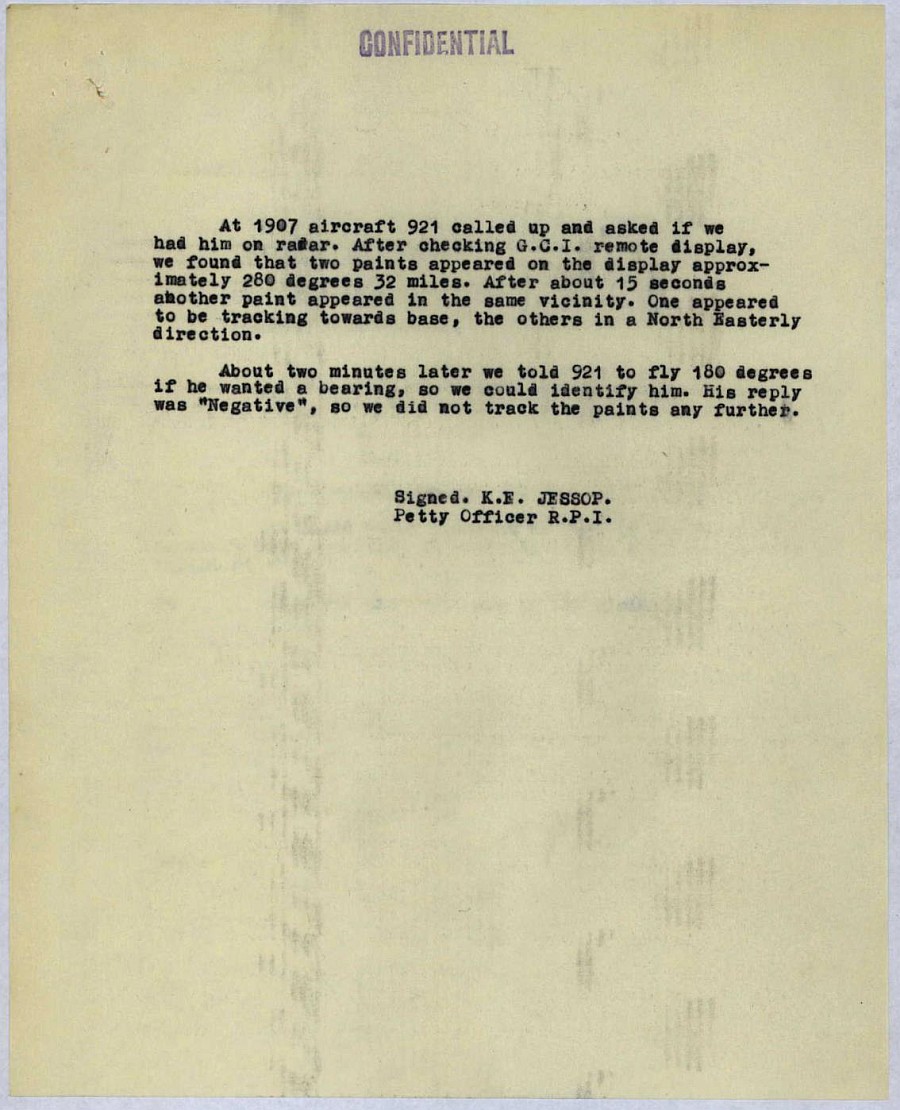
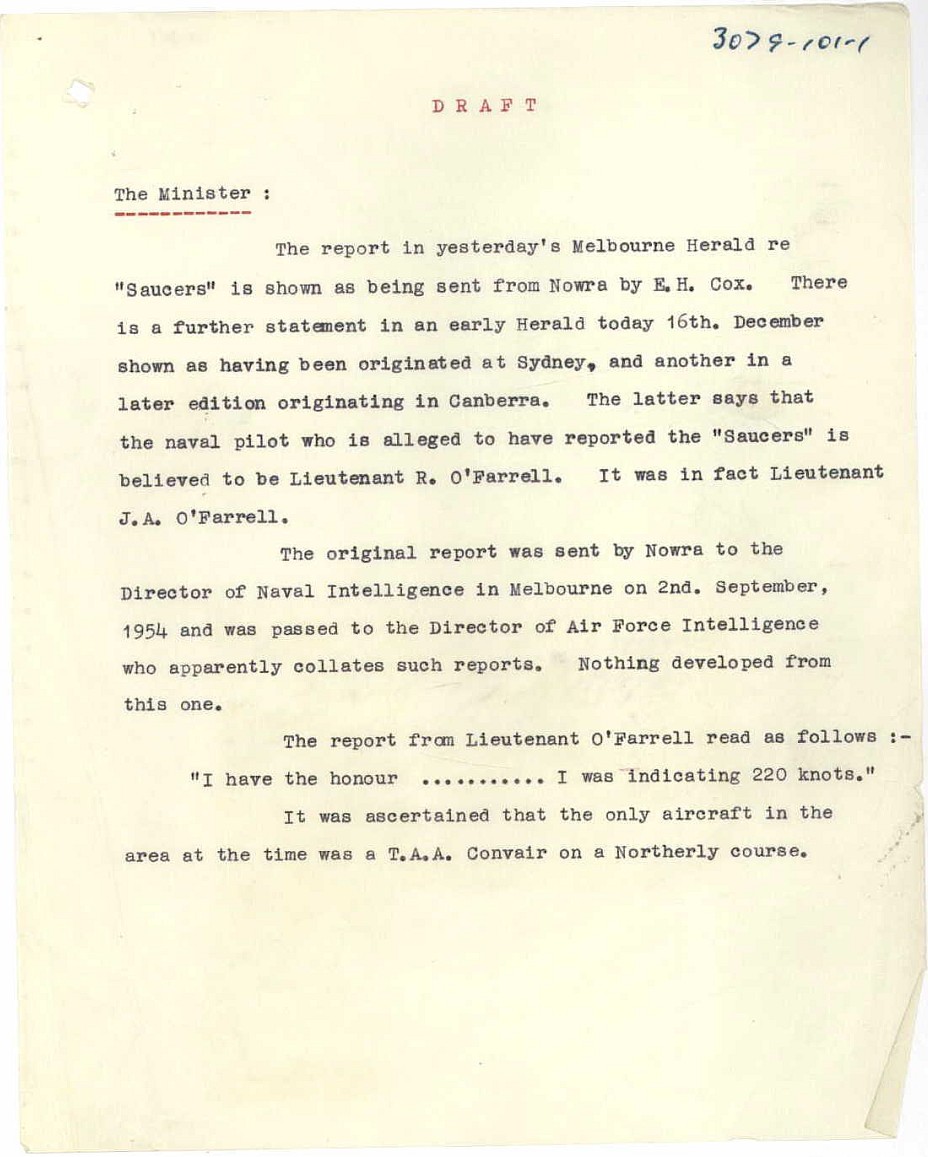
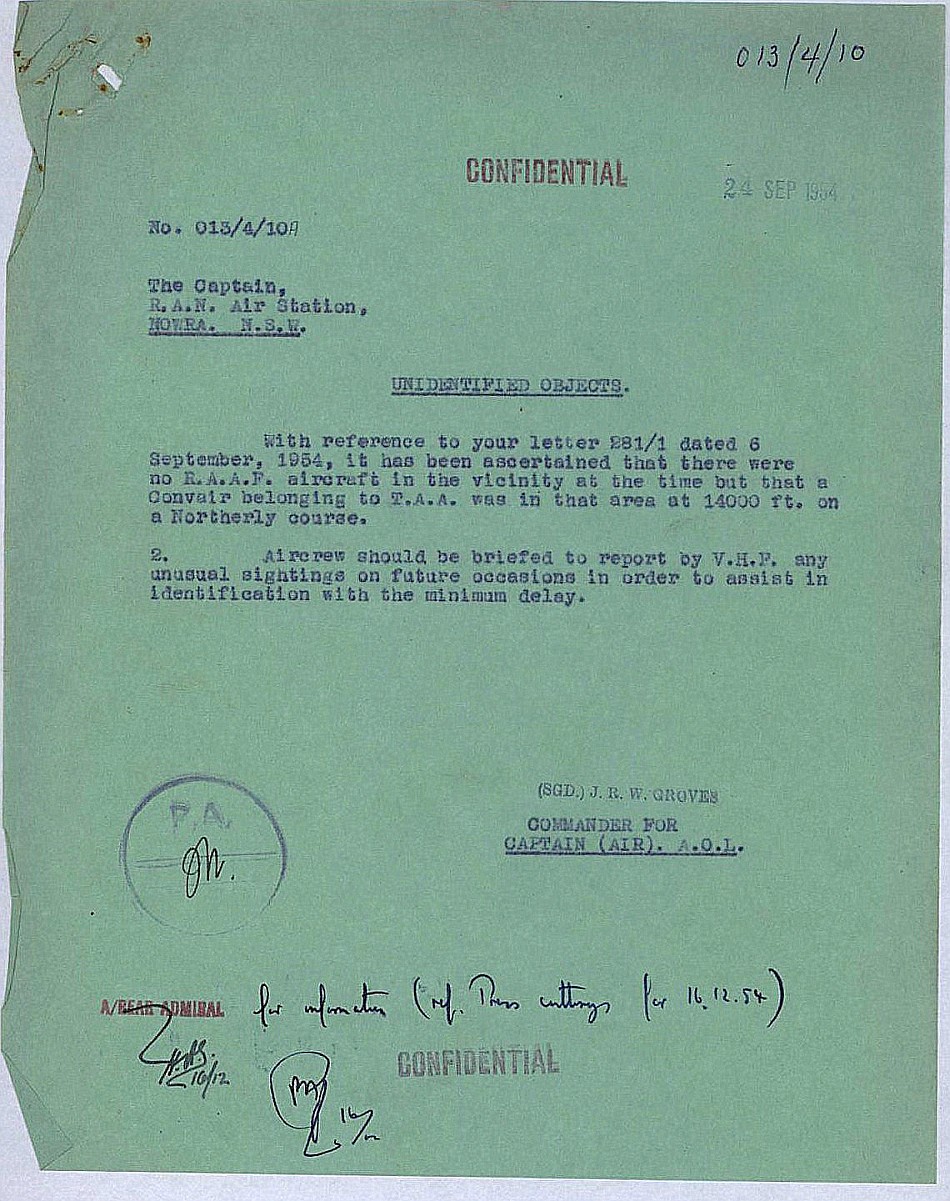
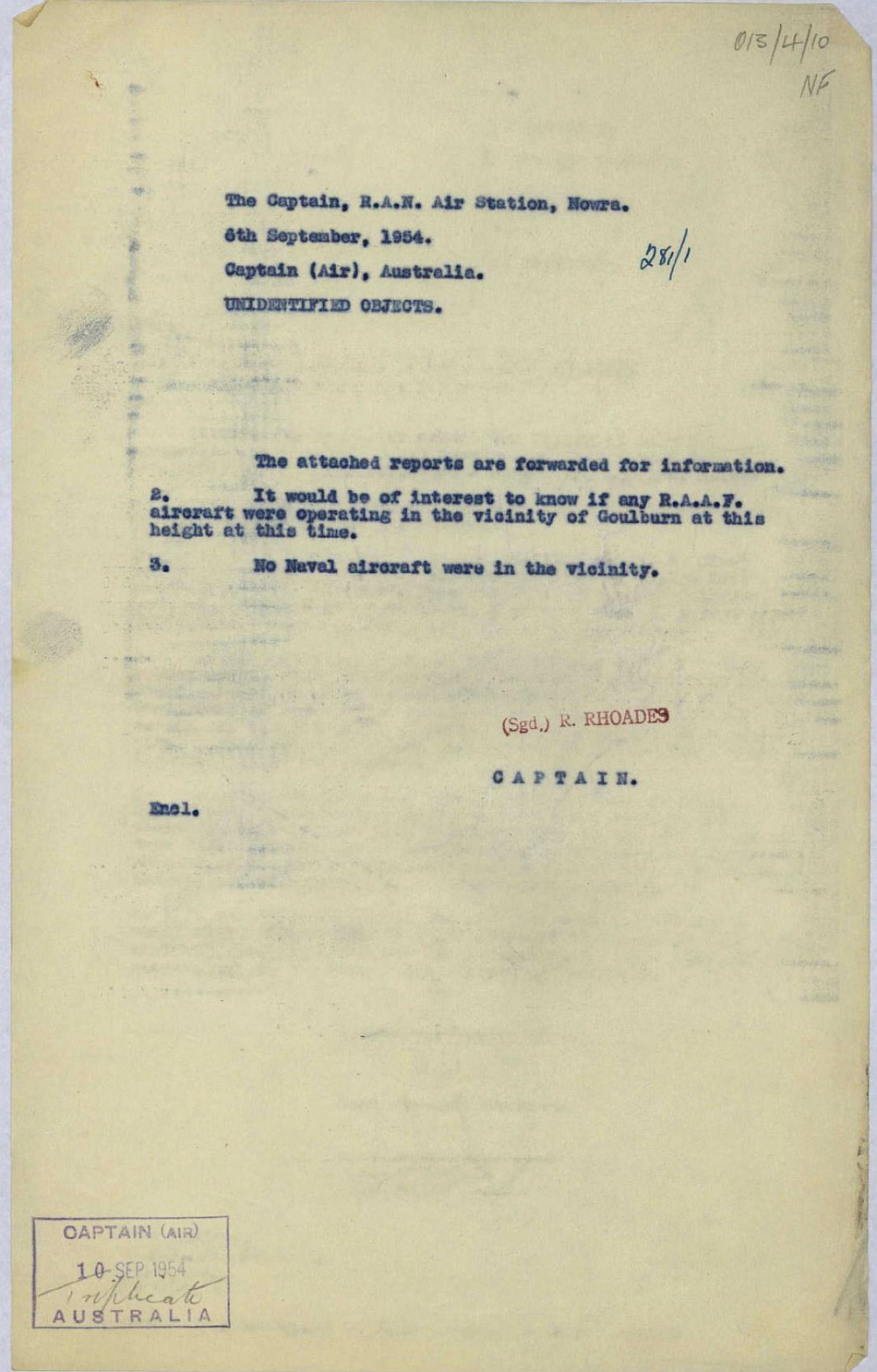
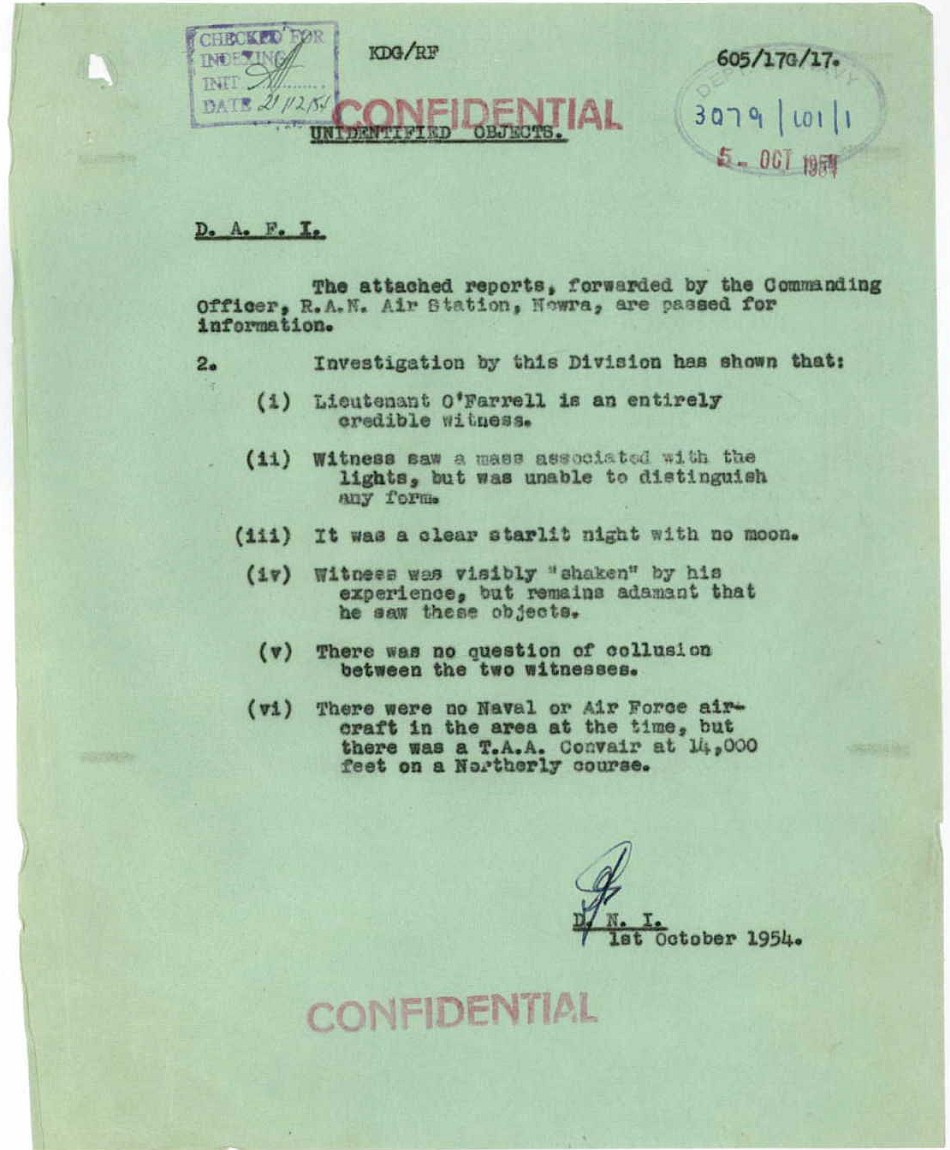
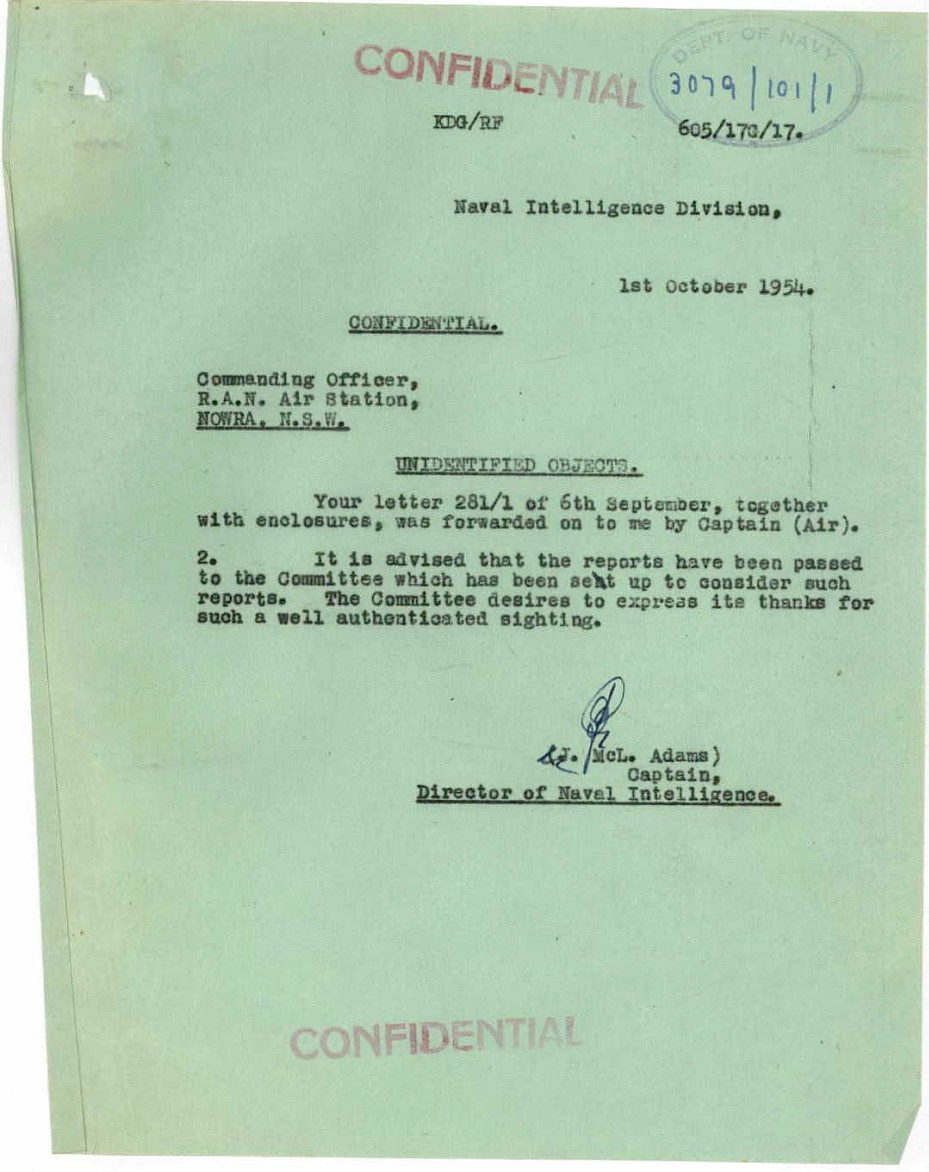
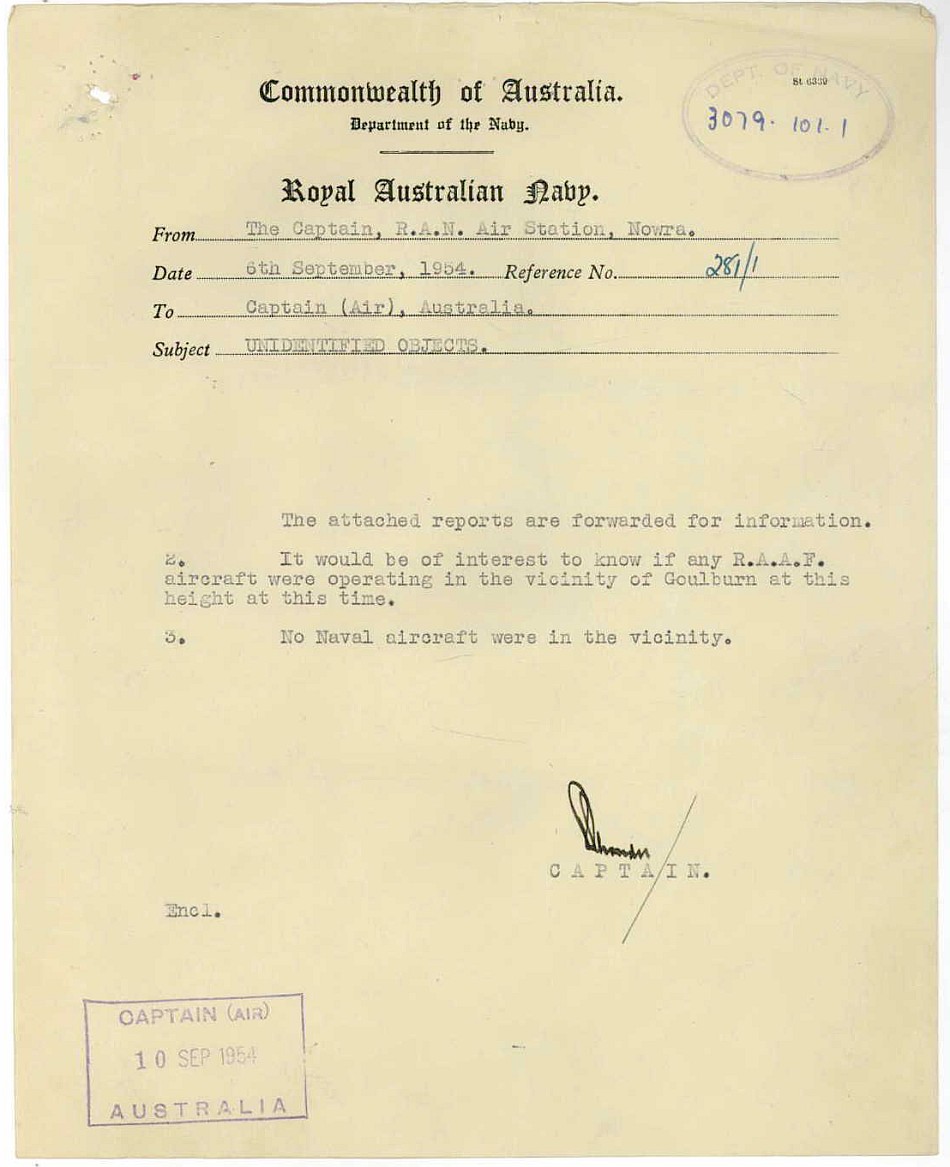
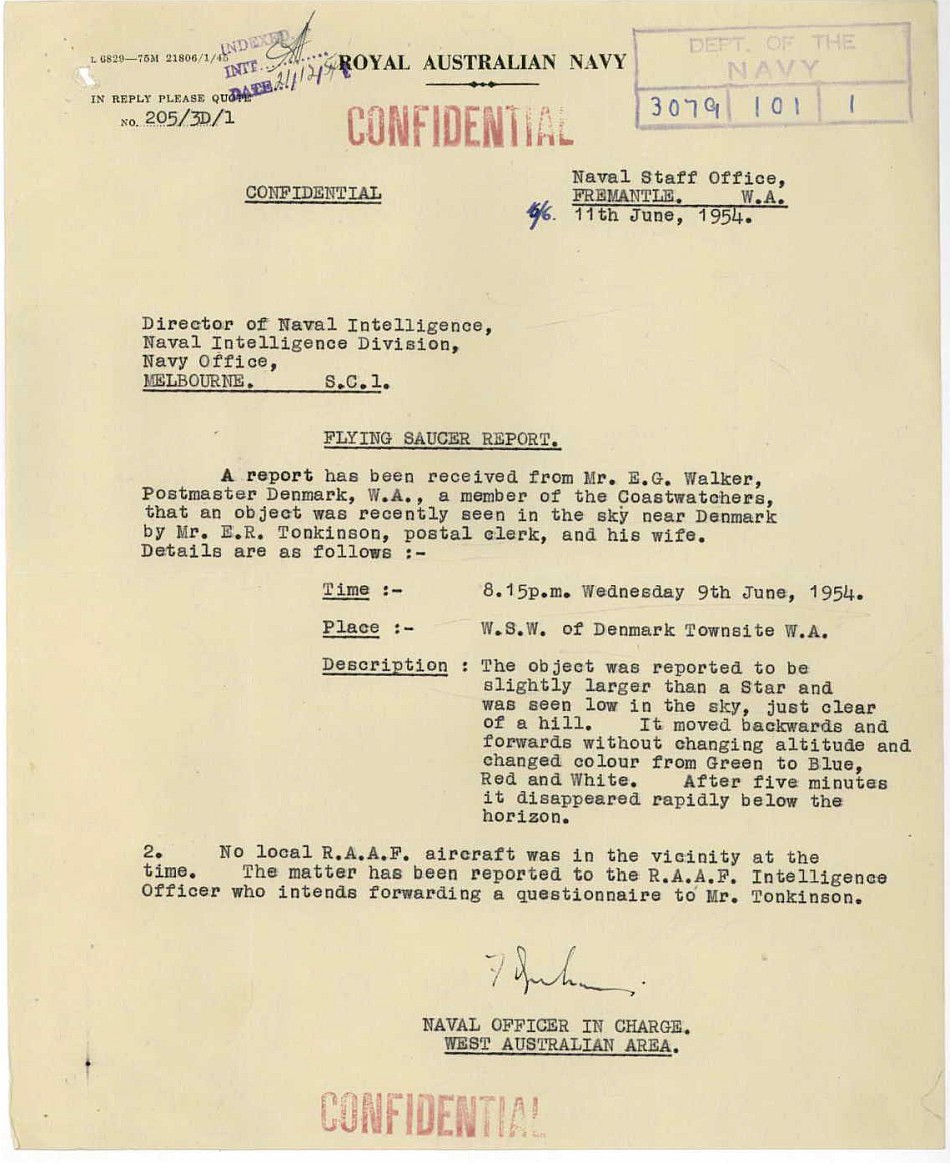
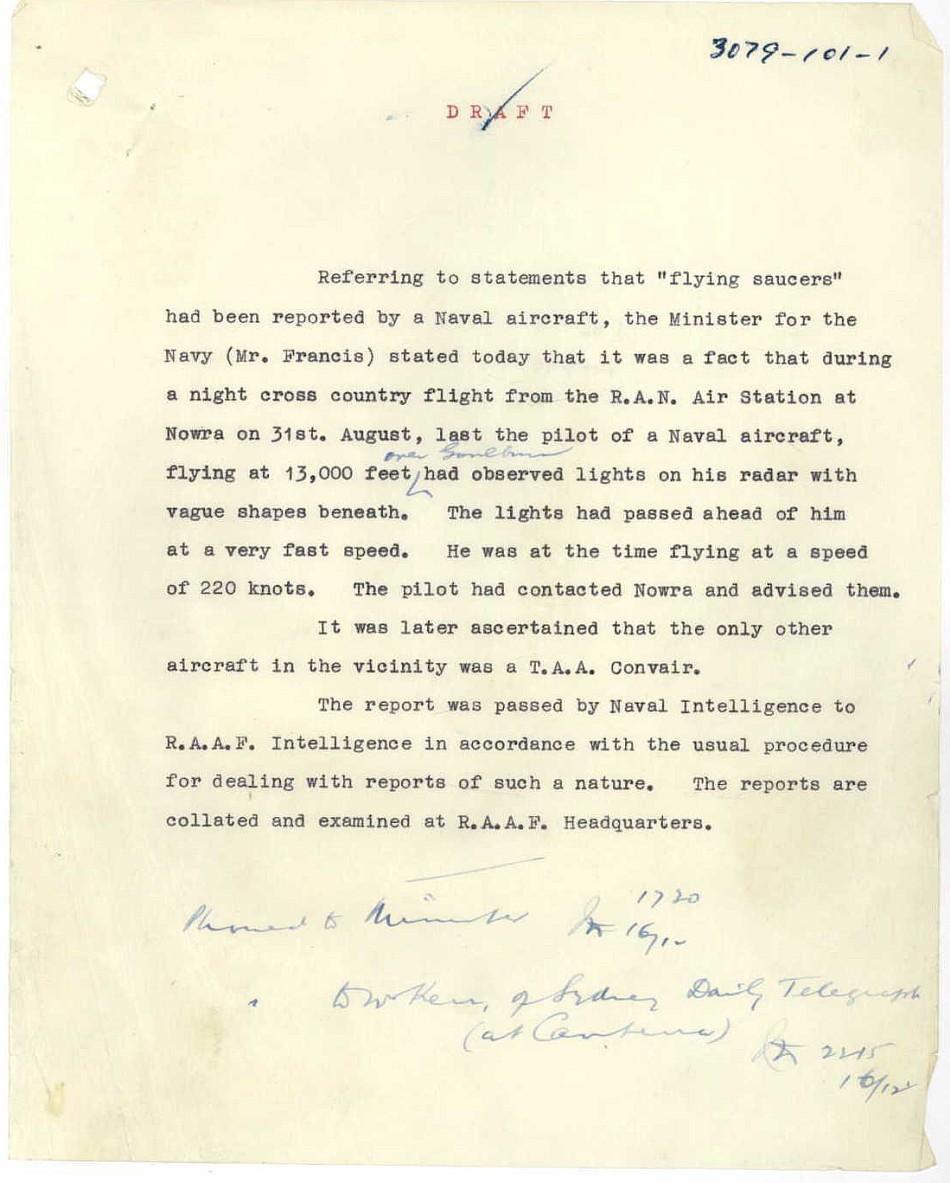
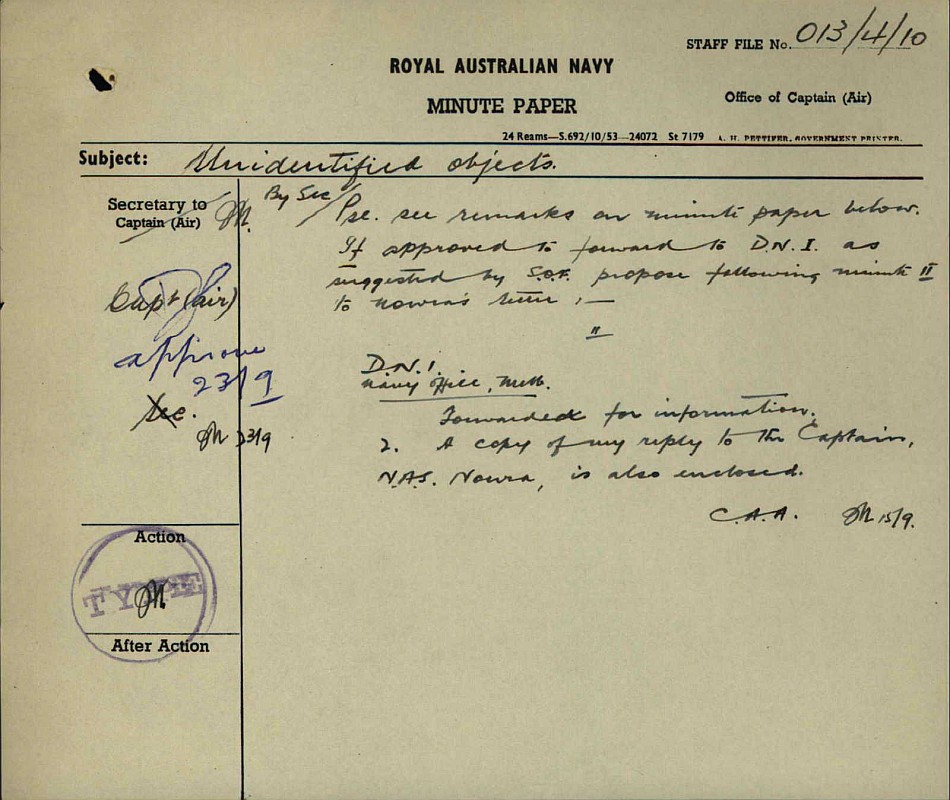
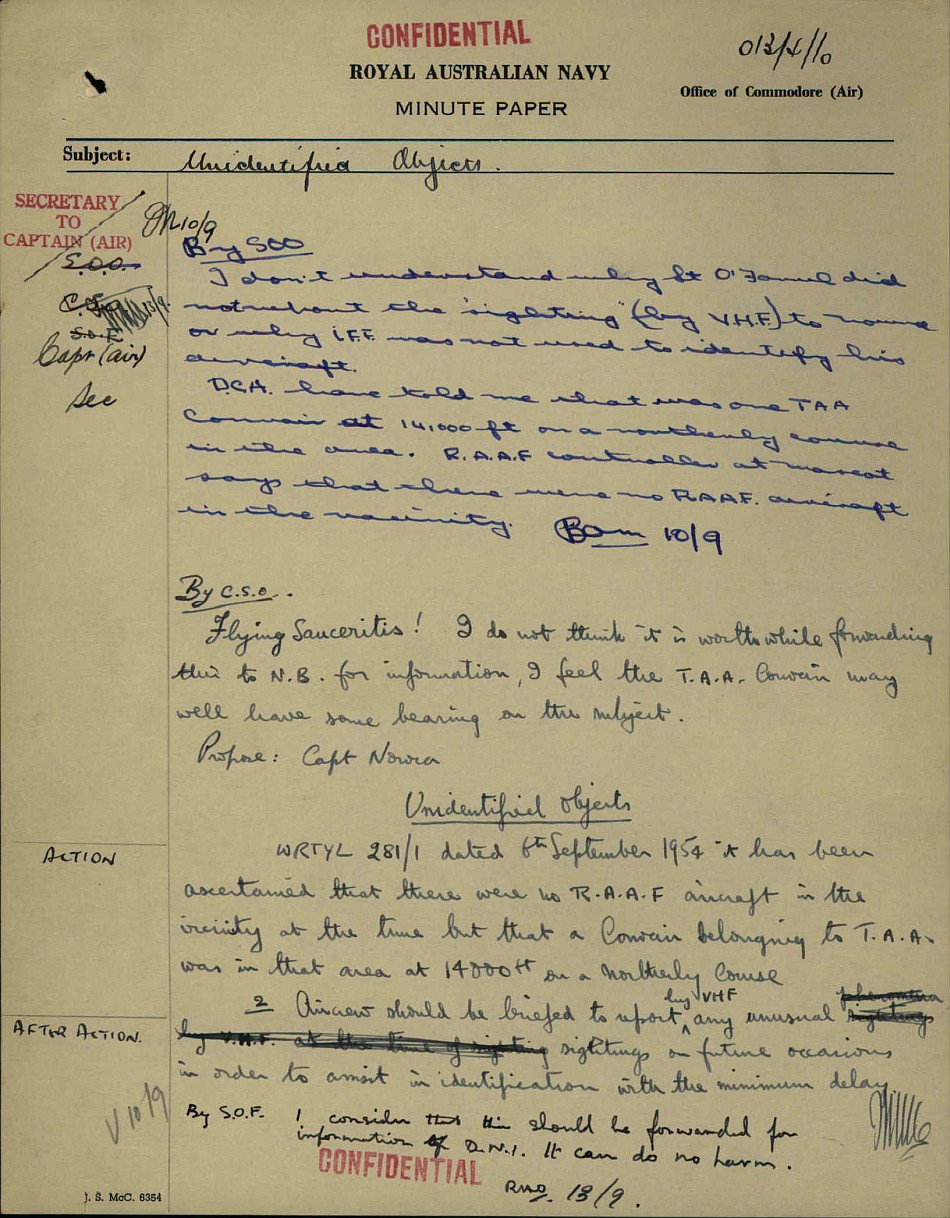
Section 5 - BACKGROUND INFORMATION
HMAS Albatross (Air Station) Nowra
The most important location for the Sea Fury incident is Nowra Air Station where O'Farrell was stationed, and where the radar operator Jessop observed and verified the two-unexplained aircraft. As with all my projects, I include background research of all important locations.
Nowra Air Station, whose official name is HMAS Albatross Naval Air Station (NAS) Nowra located at Nowra New South Wales. It is an airfield operated by the Royal Australian Navy (RAN). The base was first established in 1941 as a RAAF base (RAAF Nowra). It was transferred to the Royal Australian Navy in 1944 and renamed HMS Nabbington and operated as a Naval Air Station until 1945 when it was decommissioned. The airbase was re-commissioned back to the Navy in 1948 and renamed HMAS Albatross as a primary shore base for the Fleet Air Arm of the Navy. As from 2011 the Navy Feet Air Arm still operates from Nowra. Today Albatross Air Station now serves as the home base for the four helicopter squadrons of the Fleet Air Arm, and the Navy Aviation Group. The Naval base has the unusual distinction of being shared by a small civilian passenger terminal. Until 2004 the Royal Australian Navy Gliding Association (RANGA) also operated from Albatross with a small fleet of both Navy and civilian gliders.
The Name HMAS Albatross comes from Australia's first sea plane carrier that was launched in 1929. The ship suffered with the aircraft assigned to it. The aircraft assigned to it were retired just before the ship entered service. The new aircraft could not be catapult launched and the new designed aircraft didn't begin service until after the Albatross was demoted from sea going statues in 1933. After five years in reserve the Albatross was transferred to British Navy to offset payment for the purchase of the HMAS Hobart in 1937. The Albatross had very little use until the outbreak of World War Two. From 1943, the Albatross was converted into a ‘Landing ship’ to support the Normandy landings and was used to repair landing craft. The Albatross was torpedoed in October 1944. It was repaired and served as a mine sweeper in 1945, until the end of the war when it was decommissioned. The Albatross was sold into private hands in 1946 and after having been sold a number of times was renamed Hellenic Prince in 1948 and was converted to a passenger liner. The vessel was chartered by the International Refugee Organisation to transport refugees from Europe to Australia. In 1953, the ship became a troop ship during the 1953 Mau Mau Uprising. It was finally broken up for scrap in 1954.
I know I got off track but I do like to do background research about locations and names.
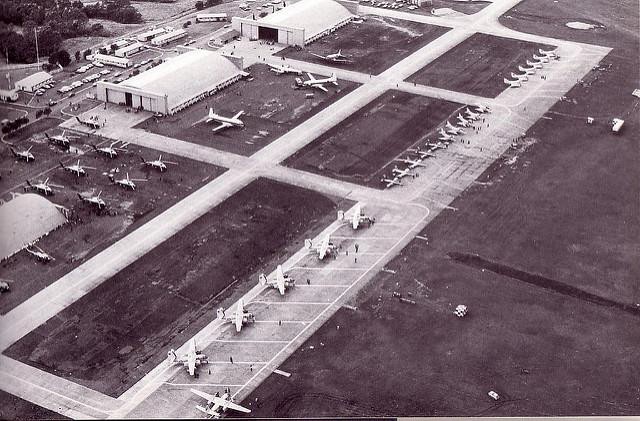
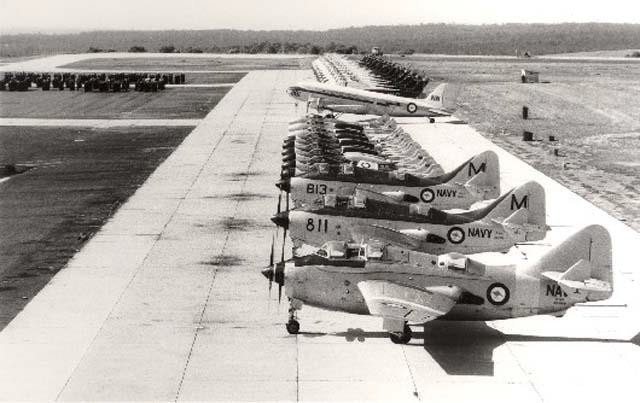
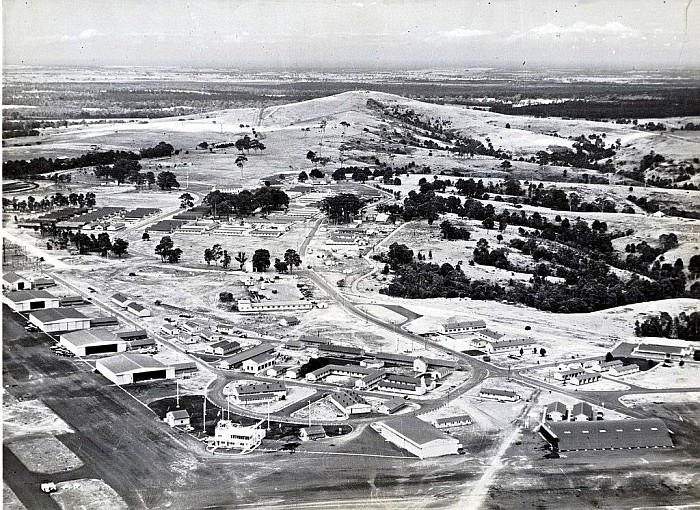
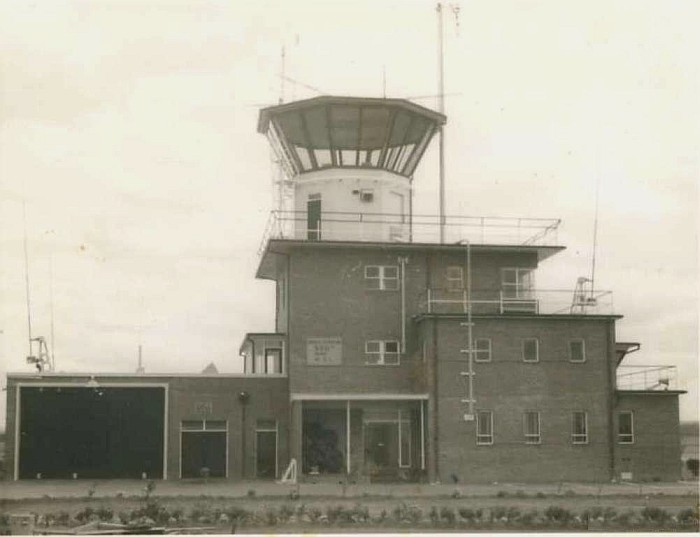
Additional Information about HMAS Albatross Air Station Nowra:
• Operator: Royal Australian Navy.
• Location: Nowra, New South Wales Australia.
• Elevation: 122 metres.
• Coordinates: 34° 56’56”S 150° 32’13”E
Runways: 1. Direction: 03/21, Length 2,046 metres, Surface Asphalt.
2. Direction: 08/26, Length, 2,094 metres, Surface, Asphalt.
Towns that the Sea Fury flew over during the training mission:
Nowra, NSW:
Nowra is 160kms southwest of Sydney. First established in 1852. The region around Nowra is a farming community, with a strong dairy industry and a number of state forests. In recent times, it has become a leisure and retirement area for Canberra and Sydney. The HMAS Albatross Navy Air Station is approximately 10 kms from Nowra. The name Nowra, originally written by European settlers as 'nou-woo-ro' (pronounced Nowa Nowa by the Aboriginals of the area) is an Aboriginal word for 'Black cockatoo'. In 2015 the population of Nowra was 35,920.
Coordinates: 34° 53'S; 150° 36'E
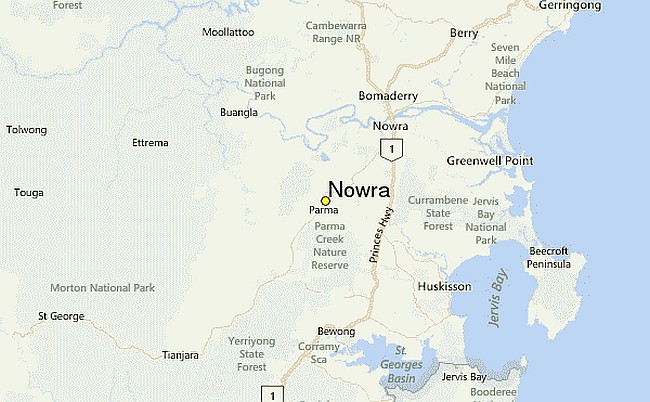
Yass, NSW:
Yass is 279kms from Sydney and 59kms from Canberra in the Southern Tablelands of NSW. Was first established in 1837. Has a population of 5,591 people (2011 census). The name Yass is an Aboriginal word meaning ‘Yarrh’ (or ‘Yharr’), meaning 'running water.’
Coordinates: 34° 49'0” S; 148° 54'0”E.
Young, NSW:
Young is a town in the South West slopes region of NSW, and was first established in 1826 as the Burrangong station by James White. 372 kms from Sydney. Young has a population of 6,960 people at the 2011 census. Young is considered the Cherry Capital of Australia. The town is named after Sir John Young, the Governor of NSW from 1861 to 1867.
Coordinates: 34° 18'0” S; 148° 18'0” E.
Temora, NSW:
Temora is in the north-east of the Riverina area of NSW, 416 km/s from Sydney. Has a population 3,874 according to the 2011 census. Temora started as a pastoral station in 1847. After gold was discovered in the area, and a small village was established. It was in 1880, when the town was officially named Temora by John Donald McCanish. The name Temora is from the Celtic term, which means, ‘an eminence commanding a wide view’.
Coordinates: 34° 26'0”S; 147° 32'0”E.
Goulburn NSW:
Goulburn is a regional city in the Southern Table Lands of NSW, 195kms from Sydney and 90kms from Canberra. It has a population of 23,005 people according to the 2015 census. It was first established in 1833 and it was proclaimed as the first inland city through letters by Queen Victoria in 1863. Goulburn was named by the surveyor James Meechan after Henry Goulburn, Under Secretary for War and the Colonies. Goulburn is also the home of the monument of the ‘Big Merino’ which is the largest concrete constructed sheep in the world.
Coordinates: 34° 45'1” S; 49° 37'7” E.
Secondary Locations:
Secondary locations are locations where witnesses other than the pilot or radar operators observed the two objects.
Marulan, NSW:
Marulan is a small town in the Southern Tablelands of NSW, and is located south-west of Sydney, with a population of 1,382 people according to the 2011 census. Marulan was first established in 1868. Originally Marulan was known as Mooroowoolen.
Coordinates: 34° 43'S; 150° 00'E.
Sydney Airport (Kingsford Smith Airport)
Sydney Airport is an International Airport in Sydney, NSW. Located 8 kms south of the city centre in the suburb of Mascot. It is the primary airport serving Sydney, and prime hub for Qantas, Jet Star and Virgin airlines. Sydney airport has three runways. Sydney Airport is both the longest continuously operated airport and the oldest commercial international airport in the world. Is also the busiest airport in Australia, and is the 38th busiest airport in the world.
Coordinates: 33° 56'46” S; 151° 10'38”E.
Aircraft Involved
Hawker Sea Fury
The aircraft flown by Shamus O'Farrell was a Hawker Sea Fury on the night of the incident. The Sea Fury was a British fighter aircraft designed and manufactured by Hawker. It was one of the last of the propeller powered fighters to service the Military. It is the fastest production single piston engine aircraft ever built. Developed during World War Two, the Sea Fury had its first flight in February 1945 and entered service in the Royal Navy in October 1945.
Australia was one of three commonwealth nations to operate the Sea Fury. It was operated by two frontline squadrons of the Royal Australian Navy, the 805 Squadron and 808 Squadron; a third squadron also flew the Sea Fury briefly, which was the 850 Squadron. Two Australian Aircraft Carriers, HMAS Sydney and HMAS Vengeance, used Sea Fury's in their air wings. The Sea Fury was used by Australia during the Korean War, flying from Aircraft Carriers based along the Korean coast in support of the United Nation Forces. The Sea Fury was operated by the Australian Navy from 1948 to 1962.
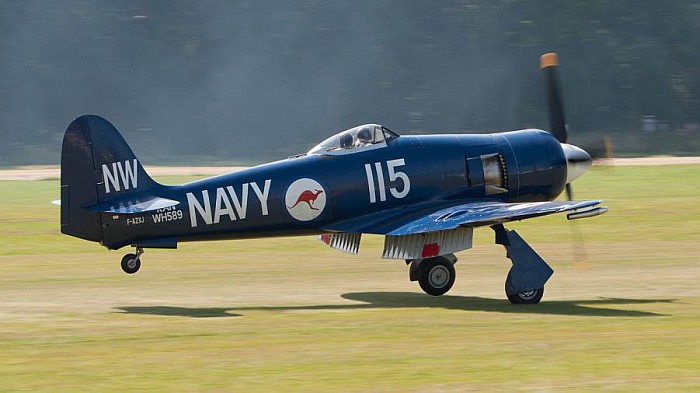
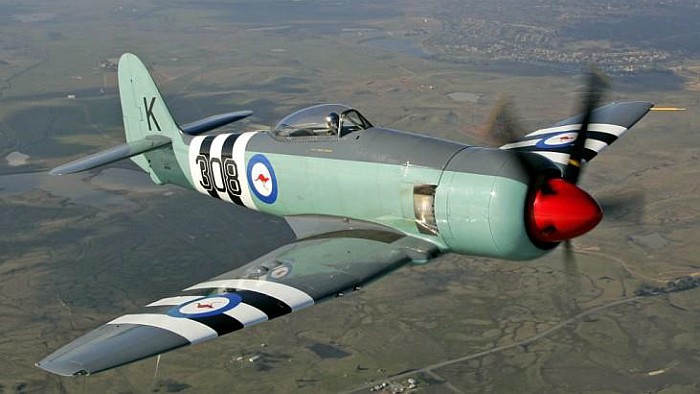
Specifications of the Hawker Sea Fury:
General characteristics:
• Crew: One.
• Length: 10.6 metres.
• Wingspan: 11.69 metres.
• Height: 4.84 metres.
• Wing area: 26.01 metres.
• Empty weight: 4,191 kg.
• Loaded weight: 5,602 kg.
• Max. Take-off weight: 6,645 kg.
• Power plant: 1x Bristol Centaurus 18, 18-cylinder twin-row radial engine, 2,480 hp (1,850kw) (take off)
Performance:
• Maximum speed: 740km/hrr (400 knots) (460mph)
• Range: 1,126 km (700mi, 609nmi) with internal fuel. 1,674 km (904 nm, 1,040mi) with two drop tanks.
• Service ceiling: 10,910 metres (35,800ft)
• Rate of climb: 4,320ft / per minute (21.9 m/s).
Weapons:
• Guns: 4x20mm (.79in) Hispano MK V cannon.
• Rockets: 12x3 in (76.2mm) rockets or
• Bombs: 907 kg (2000 lb) bombs.
A second aircraft
I would like to introduce a second aircraft, one that has been ignored or lost in the investigation of the Sea Fury incident. In all the modern research and material released on the Sea Fury incident, it has been reported that there were no other military aircraft in the air and that all civilian aircraft had landed.
This appears to be incorrect, as the original 1954 files tell a different story. Apparently, there was a TAA 240 Convair airliner in the air at the time. In Document 605/17G17, last dot point it says, ‘There were no Naval or RAAF aircraft in the air at the time but there was a TAA Convair at 14,000 ft on a northerly course.
In fact, it wasn't even confidential as the TAA Convair was mentioned in one of the newspapers regarding the Sea Fury incident in 1954. In the Argus, dated 17th December 1954 we read, ‘It was ascertained, that the only other aircraft in the vicinity was a TAA Convair.’
So, to be clear, although this is not the aircraft involved in the radar incident, there was one other known aircraft in the vicinity during the time of the Sea Fury incident. This does make me wonder why this aircraft had never been mentioned, as it was mentioned in the news media of the time. Also, I am curious why Shamus O'Farrell and Keith Jessop never mentioned this TAA airliner as they must have known about it as this information was not confidential, as it was printed in the news media. Also, if O'Farrell was given the investigation file in 1973, this would have been included in the investigation report. Why would he ignore this small but important detail?
A brief look at the Convair 240.
The Convair CV-240 is an American airliner produced by Convair from 1948 to 1954. It was a replacement for the Douglas DC-3, featuring a more modern design, better performance,and with cabin pressurisation. The Convair was used as an airliner and there were various military varieties. The Convair in various forms still fly in the 21st Century.
In 1947, John Watkins, Engineering Manager for TAA was on a world tour looking for a replacement for their aging airline fleet. He was impressed with the Convair 240 and all its updated features including the pressurised cabin. He informed TAA's Chairman and Australia was the first operator outside the USA to place orders for the Convair.
The only problem was that the Convair was designed for the U.S domestic market and had a limited fuel range, which prohibited the aircraft from flying across the Pacific Ocean. For this reason, an alternative route would be the long way back to Australia. The flight took the first Convair across America, via Canada, Greenland, United Kingdom, France, North Africa, Arabia, India, Malaya, Singapore, Darwin, Alice Springs, and finally to Melbourne. This would set a world record for the Convair.
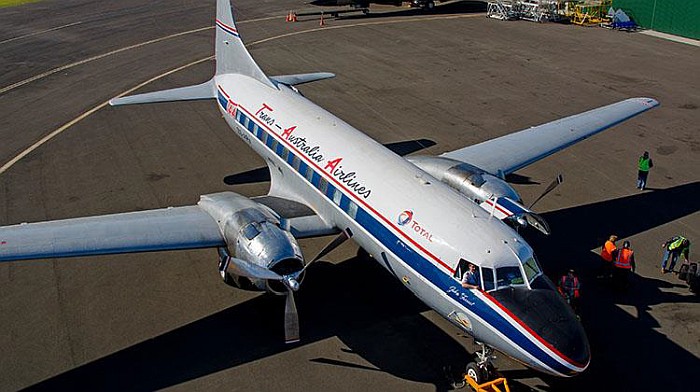
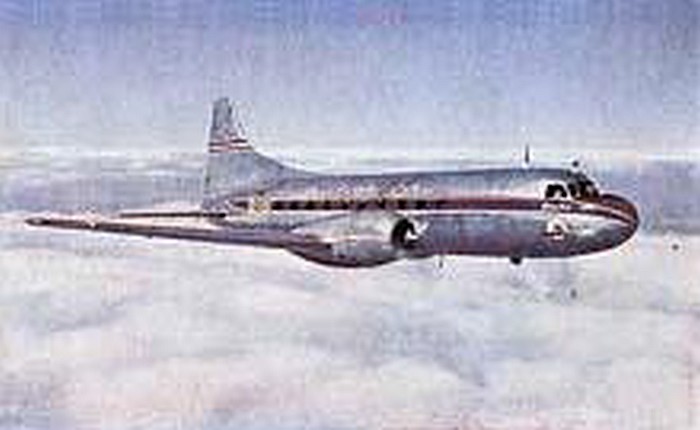
Specifications for the Convair CV-240
General Characteristics:
• Crew: 2 to 3 flight deck crew.
• Capacity: 40 people.
• Length: 22.7 metres.
• Wing span: 27.97 metres.
• Height: 8.2 metres.
• Wing area: 75.9 metres.
• Power plant: 2x Pratt & Whitney R-2800-CA3 Double Wasp /CA15 /CA18/ CB3 or CB16, 18-cylinder air cooled radial engines. 2400hp (1800KW each.
• Propellers: 3 blade Hamilton Standard or Curtiss.
Performance:
• Maximum speed: 507km/hr (274 knots)
• Cruise speed: 451km/hr (243 knots)
• Service ceiling: 4900 metres (16,000ft)
• Rate of climb: 1,520 ft/minute (7.7m/s)
Section 6 - MY HYPOTHESIS
Introduction
The Sea Fury radar incident is one of the most credible cold cases to date. The credentials that come with this case are very strong, an experienced Naval pilot, and ground radar confirmation of two objects by the radar operator. This is one of those rare cases where the events that took place are real and provable beyond reasonable doubt.
As I have been going through the available material on this case, the information put forward appeared to be constant, with very few discrepancies in the story except for the 1991 version by Ken Llewelyn where some of the technical information was incorrect. One can only ponder why some of the basic information was incorrect. It appears that Llewelyn interviewed O'Farrell for his book. Whether Llewelyn, misquoted O'Farrell, or was not a good note taker, or O'Farrell got it wrong will be speculated upon. However, looking at the bigger picture it doesn't affect the credibility of the incident.
Most of the material available appears to come from Bill Chalker's research, through interviews with Shamus O'Farrell during the 1980s and 1990s. There are a couple of elements with this case that are lacking in my opinion. There are no interviews with the radar operator, Keith Jessop, except for his part in the ‘Extraordinary’ television program, or any research attempting to uncover the mystery of the two-unknown craft that flew along with O'Farrell. The only other material I have found is Keith Basterfield’s 2012 blog where he introduced two of the original files from 1954. Although these files are not the JIB investigation files, they do add some very important questions to this case that does cause a certain amount contradiction to the O'Farrell and Jessop version of the incident. This I will discuss further on.
Although the original JIB investigation files are not available, I am going to grab the bull by the horns and put my own theory forward on what the two mysterious crafts could be. This I will do by using the available material at my disposal with a touch of speculation and hopefully common sense scenarios.
Looking for clues
This cold case is very different to most of the cases I have researched as we are dealing with two genuine craft of unknown origin that were observed by the pilot and observed on radar in real time.
So what I am dealing with is, not whether unknowns existed, but what are they and where did they come from.
The question is, are they extra-terrestrial in nature? If you read the newspaper articles from December 1954, they all use the term ‘saucers’ openly and frequently. This set the tone for this incident in 1954. It's interesting that no one involved with the incident or the researchers would say directly that the objects were extra-terrestrial but would imply it without using the word UFO.
I am going to take a different approach. I am going to look at every aspect of the incident, to look for clues that may give me an indication what these two objects could be, and where they could have come from.
To start with I am going to break down the encounter into manageable pieces in an attempt to understand what may have happened and attempt to identify what these two craft may be and where they could have come from. I am also including a comparison of the original material (1954)to the current material for consistency and accuracy.
Description of the two aircraft:
Snippets taken from Newspaper articles from December 1954:
Melbourne Herald, Thursday 15th December 1954:
• A Naval pilot flying a single seater fighter from Canberra to Nowra just after dark a few days ago was joined in the air by two strange aircraft resembling saucers.
Argus (Melbourne) Friday, 17, December 1954:
• Mr. Francis said the pilot, in a Sea Fury, observed ‘two lights on his radar with vague shapes underneath’ as he flew 13,000ft. above Goulburn, N.S.W.
1991, from the Book ‘Flight into the Ages’
• I could see two dark cigar shaped objects - not very long, about the size of a Dakota - but their central lights made the outline quite distinct. I could not see any other details, no other lights - just one bright light centrally placed over the top of each mass.
1996, The OZ Files, by Bill Chalker:
• ....‘ Was flying alone on this occasion and was returning from Yass when he saw ‘a very bright light closing fast at one o'clock’.
• Then he asked himself, ‘why am I only seeing one light, where are the port and starboard [wing] lights?’ He wondered if what he was seeing was the underneath light that comes on when the plane lowers its landing gear, but realised that what he was seeing in each case was a white light situated centrally on top of a large shape. Like the top of a football.
1996, Project 1947: By Bill Chalker.
• With that these two aircraft came quite close to me and I could really see the dark mass and that they were quite big. But couldn't make out any other lights or any other form of an aircraft.
The Sea Fury Incident: By Bill Chalker:
• O'Farrell could only make out a ‘vague shape with the white light situated centrally on top’
• ‘With that these two aircraft came quite close to me and I could really see a dark mass and that it was quite big, but couldn't make out any other lights or any other form of an aircraft.’
From original files, 1954: Original written reports on the incident by the pilot.
• (O'Farrell's original written report): I saw no other lights and was only able to make out a vague shape with a white light situated centrally on top.
• Draft from Argus newspaper: It was a fact that during a night cross country flight from the R.A.N. Air Station at Nowra on 31 August last, the pilot of a naval aircraft flying at 13,000 feet had observed lights on his radar with vague shapes.
As can be seen, the Herald Newspaper on December 16, was the least accurate article reporting that that O'Farrell was flying from Canberra to Nowra. The newspapers used the word flying saucer or saucers on a number of occasions. The Argus Newspaper was more accurate in their description of the incident.
The 1991 version of the incident by Ken Llewelyn had a number of inaccuracies in the technical data. Its description of the two crafts appeared to be more focused on the UFO theme, using the words cigar shaped and a distinct outline. The way it reads it appears to be a description by O'Farrell himself. This in itself is a bit of a mystery as why O'Farrell gave a different description in this particular interview. I also find it interesting that O'Farrell's description in the Oz Files appears to do a similar thing, using the words a white light situated on top of a large shape, like the top of a football. Yet when you read the articles on the net by Bill Chalker the description is very similar to the original version being a vague shape with a white light situated on top. Maybe it’s an author’s privilege to create a more powerful statement to enhance the description of the crafts so they appear more ‘UFO’ in the minds of the readers. Of course, it doesn't compromise the incident but it's does give the reader an exaggerated version of the original story.
So looking at the original written report by O'Farrell himself on the 4th September 1954, described seeing no other lights and was only able to make out a vague shape with a white light situated centrally on top. This would be the most consistent and accurate description as this is the one used in the original written report after the incident and the description told by O'Farrell decades later with the added description of dark mass and large.
Manoeuvres by the two aircraft:
Snippets taken from the Newspaper articles from December 1954:
Melbourne Herald, Wednesday 15, 1954:
• He called Nowra air control to trace him by radar. Nowra reported that the radar screen showed three aircraft flying together
• He later reported that two unidentified objects which flew in company with him for some time were much faster than his sea fury.
The Sun (Melbourne) 16, December 1954:
• They said the ‘saucers’ flew alongside a Navy Fighter plane and were tracked on the radar
• Just after dark the pilot saw two strange aircrafts flying nearby
• Nowra directed him to execute certain movements to identify himself. He did so and the saucers gradually drew away and vanished.
The Argus (Melbourne) Friday 17 December 1954:
• The lights passed ahead of him at a very fast speed as he flew at 220 knots (just under 250mph.
The Argus (Melbourne) Thursday, 16 December 1954.
• In the pilot’s report said that he was flying over Goulburn at 15,000 feet when he saw two lighted objects flash by
• He said they easily passed his Sea Fury propeller-driven fighter which was capable of flying at 450 mph.
1991, from the book ‘Flight into the Ages’:
• ‘I was surprised when I saw two aircraft, one on either side of me, each with a single bright light above it but with no navigation lights’....’ I was keeping a lookout, constantly scanning side to side of the aircraft to the other. They came from the astern and I looked out to one side, was another one.’ ‘...I knew everyone else would have trouble with me. They were in sight for about ten minutes - all times in immaculate formation. Then, suddenly they left me and headed off to the north-east very fast.’
1993, from the ‘Extraordinary’ program:
• O'Farrell: ‘They were in formation with me, and holding their station with me and they were about the same distance on either side
• Moss: Two unidentified craft, two brilliant lights, flying in formation with the Sea Fury. One was 30 metres on his port, the other 30 metres to his starboard.
• O'Farrell: Then I saw the rate to which they were able to open up from me. Flying ahead of me. Cross directly in front of me and take station on the other side, almost in the flash of an eye. Leaving me apparently standing still relative to their motion. And that is what makes me think. I then stopped and thought about it. It's incredible what sort of aircraft have I got out here. I knew then in my own mind, there were no aircraft in Australia that could do that.
1996, The OZ Files, by Bill Chalker:
• Flying alone on this occasion and was returning from Yass he saw a very bright light closing fast at one o'clock. It crossed in front of his aircraft, taking up a position up on his left. ‘I was a bit mesmerised,’ he recalls. Soon a second light appeared and took up position to his right. Both lights were very close, about two aircraft length away.
• The speeds of the lights, before they slowed down to track O'Farrell’s own aircraft were faster than he had ever encountered. O'Farrell grew nervous at the closeness of the aircraft. He was continually turning his head from side to side to keep track of them and finally wondered if he should call Nowra.
• Ten minutes after they had first appeared one of the lights veered in front of O'Farrell at an astonishing speed which made him feel as if he was standing still. (in fact he was travelling at 240 knots /per-hour). Then the two lights shot off and were soon out of sight.
1996, The Sea Fury Incident (Bill Chalker)
• Lt. O'Farrell was returning to Royal Australian Navy Air Station Nowra after a night cross country in a Sea Fury Aircraft. After contacting Nowra at about 1910 hours, O'Farrell saw a very bright light closing in fast at one o'clock. It crossed in front of his aircraft taking position on his port beam, where it appeared to orbit. A second and similar light was observed at 9 o'clock. It passed about a mile in from of the Sea Fury and then turned in the position where the first light was observed.
• O'Farrell, ...‘The other two aircraft appeared to be departing at high speed to the north-east.’
From original 1954 files:
• After contacting Nowra at approximately 1910, I noticed a very bright light closing fast from ‘One o'clock’. This bright light crossed ahead of me and continued to a position on my port beam where it appeared to orbit. As the same time, I noticed a second and similar light at Nine o'clock, which made a second and similar light at 'nine o'clock, which made a pass almost a mile ahead of me and then turned in the position where the first light was.
• ’Their apparent crossing speed was the fastest that I have ever experienced, and at the time I was doing 220 knots.’
The manoeuvres by the two aircraft described by O'Farrell are consistent throughout all the material I have read. I did notice that Bill Chalker's description of the two aircraft in his articles are near identical to the original report by O'Farrell on the 4th September 1954. As an observation, it appears that Bill Chalker had sighted at least some of the original documents at some stage before Keith Basterfield found them in 2008.
Radar Sighting
Snippets taken from Newspaper articles December 1954:
Melbourne Herald, Wednesday 15, December 1954.
• He called Nowra air control to trace him by radar. Nowra reported that the radar screen showed three aircraft flying together.
The Sun (Melbourne) Wednesday 16, December 1954
• They said the ‘saucers’ flew alongside a Navy fighter plane and were tracked on their radar screen before disappearing.
• Then three aircraft flying together showed up on the radar screen.
Melbourne Herald, Thursday 16, December 1954.
• At the same time the saucers were seen on the screen a Sea Fury pilot reported saucer shapes flashing past him.
The Argus, (Melbourne) Friday 17, December 1954.
• Mr. Francis said: ‘It is fact that on a night cross-country flight from Nowra on August 31, a pilot in the Sea Fury observed ‘two lights on his radar with vague shapes underneath’ as he flew 13,000ft above Goulburn.
Melbourne Herald, Thursday, 16 December 1954.
• But officers at Nowra NSW, Naval Air Station where the saucers were tracked on a radar screen are certain that ‘two objects’ were near the pilot.
• This is a clear case in which ‘objects’ have been independently recorded from the radar screen agreed exactly with the pilot’s report.
• The pilot, fearing that he might be ‘ragged’ in the wardroom on his return if he abruptly reported flying saucers, called Nowra by radio and asked whether the radar screen showed his aircraft. He gave his position. Nowra asked him to manoeuvre so he could be identified. He did, and got a reply identifying his position.
The Argus (Melbourne) Thursday, 16, December 1954.
• Two ‘flying Saucers’ have been reported by a Naval Pilot - plotted on radar - over Goulburn, 60 miles from Canberra.
• The pilot reported the incident to Nowra radar officers about 9.30pm, and radar officers, after a check revealed that there were no other aircraft in the vicinity at the time.
1991, From the book ‘Flight into the Ages’:
• ‘I had been airborne for about two hours and I was somewhere in the Goulburn region, near Canberra. When I left Nowra, the radar there was not working, but they were hoping to get it on line by the time I returned. The operators asked me to call so that they could do a check-tune on me as I came in.’
• ‘I became concerned at the presence of these objects and began to think about the situation again: ‘If I say too much they will think I am seeing objects that aren't there, and they will get worried; the best thing to do is say nothing and just call up Nowra. ‘I asked them, ‘Do you have me on radar? Back came Petty Officer Jessop's reply, ‘Yes we have an aircraft coming in from the west - in fact we have got three. ‘Which one are you?’ And I replied, ‘I am the one in the centre. ‘And then he said, ‘Fly a one-eighty for identification. So I turned through 180 degrees. ‘Yes I have got you turning in the centre,’ he said. I finally finished with a 360 degree turn because I lagged behind the other two aircraft, who had continued to move ahead. Then, when I came back up, they settled back into formation with me.
• ‘Then I started to think ‘Well, who the hell are they? Because I was cruising about 330 knots and, apart from the RAAF's Meteors. I knew everybody else would have trouble staying with me. They were in sight for about ten minutes - at all times in immaculate formation. Then, suddenly they left me and headed off to the north-east, going very fast. I was about to press the transmit button when Nowra radar contacted me and said, ‘Those other two contacts are leaving the screen fast to the north-east.’ I said, ‘Roger’ and felt relieved that they had gone.
1993, From ‘The Extraordinary’ program:
• The first two legs of the flight was uneventful as Lt. O'Farrell turned into his last leg. Petty Officer noticed something unusual happening on his radar screen. Two strange echoes. Echoes that were closing in fast on the Sea Fury.
• Petty Officer Keith Jessop: What these two objects were, I didn't have any idea, and I was concerned with the safety. I reported it to the relevant officer in charge of the area at the time.
• Reconstruction: 921, we have you on the screen with two other echoes, can you confirm. 921, tracking at 13,000ft with 2 other aircraft.
• O'Farrell: They were in formation with me, and holding their station with me and they were about the same distance at either side.
• Reconstruction: Jessop: 921, can you identify the aircraft. O'Farrell: 921, Negative.
• Moss: Try to picture Shamus O'Farrell's predicament. When he left Nowra, he had been briefed that there would be no other aircraft in the flight path. Suddenly he was confronted with the impossible. Two unidentified craft. Two brilliant white lights. Flying in formation with the Sea Fury. One was about 30 metres on his port side, the other 30 metres to the starboard.
• Jessop: At the time, there shouldn't have been anything else there and I brought it to the attention of the Naval Officer in charge and the staff. And they were equally surprised. We did plot on our radar screen all three objects. And it had been something because we wouldn't have got a radar echo, as we call them, back to the radar room. If it had not been a substance that reflected our radar beam.
• Reconstruction: Nowra Base 921... Can you execute a 180 degree turn so we can identify your position. 921...complete 360 degree return to track...over.
• Moss: By this time there was a minor panic in the radar room at Nowra. They started checking the data and double checking. The RAAF confirmed they had no planes in the air that night. Sydney Airport that there were no civilian aircraft flying in the area. And up above two objects were maintaining formation with the Sea Fury and that after several minutes they confounded everyone. They sped away into the night.
• Reconstruction: Nowra Base 921... confirm the two echoes to the north-east, over. Confirmed...objects have left formation, on track to the north-east.
1996, The OZ Files, by Bill Chalker:
• He thought about and decided to call them. ‘Nowra, this 921....do you have me on radar? ....Affirmative 921....‘We have you coming from the west. We have another two contracts as well.’ At this point O'Farrell recalls being very relieved. He said to Nowra, ‘I could kiss you!’ He was convinced they were high performance aircraft. He did a quick 360 degree turn. ‘Yes we're got you, said Nowra. You're the central aircraft’. ‘That is correct’ ... ‘Who are the two-other aircraft?’ .... ‘I don't know, was hoping you would tell me, because I didn't think there was anyone up here’..... ’Well there shouldn't be, and they shouldn't be that close to you.
Project 1947, By Bill Chalker 1996: (interview with Shamus O'Farrell)
• ‘I said, Nowra, this is 921. Do you have me on radar?’ And a few seconds later they came back and said, ‘Affirmative 921’. We have you coming in from the west. We have another two contacts as well. Which one are you?’
• ‘I said, ‘I think I'm the central one’. And so they said, ‘Do a 180 ... for identification’. ‘So I did a quick 180 and then continued on around and made a 360 back to where I was going.’
• ‘They said, ‘Yes we've got you. You're the central aircraft.’ ‘I said that is correct’. They then said to me. ‘Who are the other two aircraft, ‘and I said, ‘I don't know’. ‘I was hoping you could tell me, because I didn't think there was anyone up here’. They said, ‘Well there shouldn't be, and they certainly shouldn't be that close to you.
• I was about to press the button and tell them that the two aircraft were departing when Nowra called me and said. ‘The other two aircraft appear to be departing at high speed to the north-east. Is that correct?’ and I said, ‘Yes’. And they said, ‘Roger’, we'll see if we can track them. ‘They tracked them for a while and then lost them.
Original 1954 files:
• Shamus O'Farrell's report: Paragraph 5: I contacted Nowra and asked if they had me on radar, hoping they would confirm that other aircraft were in the vicinity. They replied that there were 3 echoes and advised me to turn 180 degrees (course), to be identified if I required a homing. At this stage, the two bright lights reformed at Nine o'clock from me and disappeared on a North-Easterly heading.
• Petty Officer K.E Jessop report: At 1907 aircraft 921 called up and asked if we had him on radar. After checking G.C.I. remote display we found that two paints appeared on the display approximately 280 degrees 32 miles. After about 15 seconds another paint appeared 32 miles. After about 15 seconds another paint appeared in the same vicinity. One appeared to be tracking towards base, the other in a northerly direction. About two minutes later we told 921 to fly 180 degrees if he wanted a bearing, so we could identify him. His reply was ‘NEGATIVE’, so we did not track the paints any further.
The events surrounding the radar sighting aspect of the incident is consistent with very little variation. The newspapers from December 1954 are all very similar, all saying how two aircraft were observed on radar by Nowra Navy Air Station. Later literature from the 1980s and 1990s were consistent, with very little variation. O'Farrell said in all his interviews including the Extraordinary TV program that he was asked by Nowra to execute a 180 degree turn so he could have his position identified. Then O'Farrell continued on around and made a 360 degree back to his original position.
What is important to note is that the actual tapes of the communication between O'Farrell and Jessop at Nowra have been erased or lost by the Defence Department (that is speculation by the researchers). This means that the material used comes from the memory of Shamus O'Farrell himself. ‘The Extraordinary’ program acknowledged this, that the material they used comes from the recollections of Shamus O'Farrell and that it was as close as possible to the real event.
There has not been any question of the accuracy or concern of O'Farrell's version of event regarding his conversation with Nowra or the manoeuvres he claimed to have made until Keith Basterfield uncovered the original files containing O'Farrell's and Jessop's report regarding the incident. The original 1954 reports by O'Farrell and Jessop tell a different version of events. One might even say this is what they call a smoking gun that came out of left field.
In all O'Farrell's interviews, he has always maintained that Nowra advised him to do a 180 degree turn so he could be identified. He has always maintained that he followed through with this, making a 180 degree turn and finally finished with a 360 degree turn to get back into formation with the two mysterious craft.
It is correct that he was advised by Nowra to do a 180 degree turn in order that he could be identified but the original reports show that he may not have actually done the suggested manoeuvre. And this is stated very clearly in Petty Officer Jessop's report.
In Paragraph 5 of O'Farrell's report it reads: ‘I contacted Nowra and asked if they had me on radar, hoping they would confirm that other aircraft were in the vicinity. They replied that they had 3 echoes and advised me to turn 180 degrees (course), to be identified if I required a homing. At this stage, the two bright lights reformed at 9 o'clock from me and disappeared on a north-easterly heading.
Petty Officer K.E Jessop's report reads: ‘At 1907 aircraft 921 called up and asked if we had him on radar. After checking G.C.I. remote display, we found that 2 paints appeared on the display approximately 280 degrees 32 miles. After about 15 seconds another paint appeared in the same vicinity. One appeared to be tracking towards base, the others in a North Easterly direction.
About two minutes later we told 921 to fly 180 degrees if he wanted a bearing, so we could identify him. His reply was ‘Negative’, so we did not track the paints any further.’
What we have here is a different set of events to what has been previously been reported. Reading O'Farrell's report, he was asked to conduct a 180 degree turn to be identified but in his report, he never stated that he did such a manoeuvre. What he does state is ...’At this stage the two bright lights reformed at nine o'clock from me and disappeared on a north easterly heading.’ To me, this implies that the two aircraft sped away in a north easterly direction before he was advised to make the 180 degree turn.
This I believe is backed up by what Jessop writes in his report: (Second paragraph) ‘About two minutes later we told 921 to fly 180 degrees if he wanted a bearing, so we could identify him. His reply was ‘Negative’, so we did not track the paints any further’.
Jessop very clearly states that when he asked O’Farrell to turn 180 degrees his reply was ‘negative’ in other words ‘NO’ to the 180 degree turn. Which in my opinion strongly suggests that he did not want to do or saw any need to do a 180 degree turn and that he never in fact did the turn.
Reading O'Farrell's and Jessop report, I think that it is plausible that he said ‘negative’ to the 180 degree turn because the two aircraft had in fact left him at high speed in a north easterly direction so there was no real need for him to do the turn to be identified.
Jessop does say in his report in the first paragraph that ....one appeared to be tracking towards base, the others in a northerly direction’. According to Jessop's account, he advised O'Farrell to fly a 180 degree turn two minutes after the two aircraft departed in a north easterly. I believe it is plausible that by this stage O'Farrell saw no reason to do the manoeuvre as he was by that stage flying on his own again.
It appears that once O'Farrell said ‘negative’ to the 180 degree turn, the consequences for this action was that Jessop stopped tracking the two-other aircraft any further, only tracking O'Farrell's aircraft back to base. he states, His reply was ...‘so we did not track the paints any further’. This would have been normal and proper procedure, but the repercussions for this action was the two mysterious aircraft were lost to the radar, disappearing in a north easterly direction.
This chain of event changes the dynamics of the incident. We still have two mysterious aircraft that companied O'Farrell's and they were picked up on radar. There was communications between O'Farrell and Jessop. But the manoeuvres that have been described by O'Farrell and the communications between him and Jessop that have been made so famous have now been compromised. O'Farrell for whatever reason appeared to alter is version of events that now in some parts contradicts the events that he put in his original report.
The events in the original 1954 reports are important and informative, and this doesn't change the dynamics of the credibility for the original incident. What has changed is the interpretation and accuracy of O'Farrell's claims that he made the 180 degree turn to be identified. We will probably never know why he altered his version of events, maybe it was just a bit of exuberant exaggeration, and maybe he thought the original files were lost, and no one would ever know or it could be as simple as his memory became foggy over the distance of time.
Other Witnesses
There were two other witnesses on the ground that supposedly observed the two mysterious aircraft that night. With these two witnesses, I must tread carefully as there is no official documentation to verify these witnesses. What we do know is that according to an interview with Bill Chalker, O'Farrell said that in 1973 he was to meet Dr. Hynek to discuss the 1954 incident. O'Farrell said he didn't have all the facts as they were a bit hazy. So, Sir. Arthur Tange (Secretary of Defence at the time) arranged for the Defence Department files to be sent to O’Farrell to read to refresh is memory.
There is no documentation to tell us where O'Farrell sourced the two witnesses, it could have been as early as 1954 but it most likely would have been from the files that he refreshed his memory with in 1973. It appears from these files O'Farrell first found out about the two witnesses. O'Farrell introduced the two witnesses to Bill Chalker during their interviews. This is how they have become a part of the Sea Fury story. What is lacking is any verifiable official documentation as to whom these two individuals were, or any real detail of what they observed. Although the information is very helpful, we are relying on O'Farrell's memories, some 39 years after the incident when interviewed by Chalker in 1993.
Witness No. 1:
Location: Marulan, New South Wales
Witness: An officer from the Department of Aviation. Carrying out repairs on the Marulan Navigation beacon.
Observation: He looked up and noticed the time when the two fast lights flashed past.
Witness No. 2:
Location: Sydney Mascot Airport, New South Wales.
Witness: Air traffic controller, in the Control Tower at the time.
Observation: Observed two lights coming over rapidly from the South-East.
What the original 1954 report does tell us is the events that unfolded in the skies above NSW were a little less dramatic than had been described by O'Farrell but never the less just as important, as now I have a clearer picture to what may have actually happened. Now I have a new theory what these two mysterious aircraft were and where they may have originated from.
For and against
Although there are a number of discrepancies between the original 1954 reports and the current literature, the story holds up very well to scrutiny and is an authentic radar visual event that can't be dismissed. The important question is what were the two mysterious aircraft that were flying with ‘O'Farrell for at least ten minutes and where did they go after they sped away? For decades, it's been assumed that it could have been some type of UFO that had capabilities that were not available in 1954. Newspaper articles from 1954 were happy to use the words flying saucers or saucers but today's researchers have been careful not to use the term UFO or extra-terrestrial but at the same time making references that the aircraft were somehow unnatural or they performed beyond anything known at the time.
I thought I would look at some of the references given to the Sea Fury incident that keeps it in the realm of UFOlogy.
1954, Flying saucers are go
• Melbourne Herald, 15 Dec. 1954: Nowra, today - Two objects believed to be flying saucers, have been recorded by radar at Nowra Naval Air Station.
• A naval pilot flying a single seater fighter from Canberra to Nowra just after dark a few days ago was joined in the air by two strange aircraft resembling saucers.
• The identity of the mysterious machines has not been discovered.
• The Sun, (Melbourne) 16 Dec 1954: Two ‘flying saucers have been recorded by (NSW) Naval Air Station.
• They said the ‘saucers’ flew alongside a Navy fighter plane and were traced on radar screen before disappearing.
• The ‘saucers’ identity is a mystery.
• Melbourne Herald, 16, Dec. 1954: Sydney today: Naval authorities admitted today that they can't find any ‘human source’ for the ‘flying saucers’ recorded on a radar screen at Nowra
• Authorities have confirmed that the pilot was ‘a man of experience’. They said they had investigated ‘every human source’ but could not logically explain the shapes.
• Herald (Melbourne) 16 Dec, 1954: Canberra today, The Naval pilot who was ‘buzzed’ by two ‘flying saucers’ is believed to be Lt. R O'Farrell, of Sydney. But the authorities have not officially revealed the pilots name.
• Naval authorities admitted today that they could not find any ‘Human’ source to the objects.
• The Argus, (Melbourne) 16 Dec, 1954: Two ‘flying saucers’ have been reported by a Naval pilot - and plotted on radar - over Goulburn 60 miles from Canberra.
• The pilot reported he had seen the ‘saucers’ flash past his Sea Fury at supersonic speed.
• The Navy report is the first authenticated information in the world of the existence of ‘flying saucers’.
• There is now a special order to Navy and RAAF pilots to watch out for unidentified flying objects.
A more conservative approach in recent times
• 1991 book, ‘Flight Into the Ages’: I could see two dark cigar shaped objects - not very long, about the size of a Dakota - but there central bright lights made the outline quite distinct. I could see no other details, no other lights - just one bright light centrally placed over the top of the mass.
• TV program 1993, ‘The Extraordinary’: ...’It's incredible what sort of aircraft have I got out here. I knew then in my own mind, there were no aircraft in Australia that could do that’ • After those two unidentified objects shot past the Sea Fury 921, the radar operator estimated the UFO's had been travelling, really, travelling at over 1000 knots.
• Chalker: One has to be reminded the credentials that come with this sighting. You have a highly qualified experienced pilot, you have confirmation from the ground from the radar operator. You have two separate witnesses all confirming two unidentified aircraft of some description. And doing things that were apparently inexplicable beyond the capabilities apparent at that time.
• Moss: A United States report rated the encounter as one of the thirteen most significant in the world.
• O'Farrell: I am convinced that they weren't planes from the Navy, Army or the Air Force, or Civil aviation. Whatever they were, they were very fast and very, very good performance.
The Military’s perspective 1954
As with any sensational event, the media will usually include an opposing view, the Sea Fury incident was no exception. Although the newspapers at the time sensationalised the incident with lots of references to flying saucers they did attempt to get quotes from the Navy and Air Force. I think it is important to have a balanced view. As this sometimes will give us clues in solving the mystery or at least making it possible to put forward new theories.
• The Sun 16, Dec. 1954: SECRET WEAPONS? In Canberra last night senior officers warned that ‘Flying Saucers’ were likely be reported in the next few weeks. They said that these would be guided aircraft and projectiles. But they refused to confirm or deny that experiments had been made with these projectiles on the coast.
• Herald, 16, Dec. 1954: Top Secret: Professor Messell of Sydney University said today that flying saucers seem to be top secret military experiments. ’No one is stupid enough to believe they come from outer space but they could be a military development’. ‘There have been so many reports from ordinary people that there could be something in them.’ In WASHINGTON, President Eisenhower said today that United States Air Force official had told him that flying saucers did not come from outer space. The President said this at a Press conference. He did not say whether he thought flying saucers existed.
• Herald, 16, Dec. 1954: This hush-hush means that either the incident is not being treated seriously or is under investigation.
• The Argus, 16 Dec. 1954: Navy pilots at Nowra and senior Navy men declare they are puzzled by the report. The pilots, many of them with combat experience in Korea, discount the possibility that the two objects could have been unauthorised aircraft.
Civilian Researchers:
When it comes to the civilian researchers, I have found very little research that looked into what the two mystery aircraft could be, or where they could have come from. Bill Chalker's research appears to be centred on interviews with Shamus O'Farrell, but no actual material that investigates the Where? What? Who? And Why? There may be unpublished material, but I have not found anything except for the same articles that have been republished or copied and pasted. The Sea Fury incident in ‘The OZ files’ only repeats the material from O'Farrell's interviews, as does the 1991 book titled ‘Flight into the Ages’. It is interesting to note that the incident in both books have the most inaccuracies, with dates, times and the speed of ‘O'Farrell's aircraft that are incorrect.
The only literature that I could find that takes a closer look at the incident and asks the important questions is Keith Basterfield’s blog (Unidentified Aerial - Scientific Research) November 2012. He did a two-part piece on the Sea Fury Incident. Keith, who found two of the missing Defence files in 2008, looked at the original reports, comparing them to the current literature on the Sea Fury Incident. In his summary he wrote, ‘One can see that by the 1991, some of the finer data points were inaccurately citied; that some of the information is simply wrong according to the 1954 documents’. Keith brought up the very important points from the original documents, the biggest surprise being that O'Farrell most probably did not make the 180 degree turn as said he did in all his interviews. Keith Basterfield’s blog can be found in full on pages 16-21 of this paper.
Time to show my hand
I have not been able to find any other theories on what the two mysterious aircraft could be or why they were harassing O'Farrell's Sea Fury. I am going to look at the incident logically, with the available evidence. I will break down the known facts that I know and follow the available clues. This will not be a definitive answer but will be at least plausible.
With any incident like this one there will always be two camps, the ones who believe it is extra-terrestrial in nature and those who believe it is not. The reason the two aircraft are considered by some to be extra-terrestrial is the way they manoeuvred, their speed and a single white light centrally placed on a dark mass. In addition, according to the RAAF and Navy, they didn't have any aircraft in the area at that time. There is also the commonly used analogy that there were no aircraft with those capabilities during that period of time in history.
The problem I have got, is that I don't know what an extra-terrestrial spacecraft should look like or how fast it can travel, or its capabilities. In fact, I still haven't seen any real verifiable evidence that they even exist in reality.
So, for this exercise I will have to compare these two mystery aircraft to the aircraft of that era.
What we do know is that the Sea Fury was the most powerful and fastest piston driven aircraft ever built with a top speed of 740 km/hr (460 m/hr 400 knots). But at the time of the incident (1910hrs) he was travelling at only 220 Knots at 13,000ft. According to O'Farrell he observed a very bright light closing in on him from one O'clock, the light crossed ahead of him and continued to position itself to his port beam where it appeared to orbit. At the same time, he noticed a second similar bright light at his nine o'clock which made a pass about a mile ahead of him and then turned in the position where the first light was sighted.
When looking at this scenario, we have O'Farrell's Sea Fury cruising at a modest speed for this type of aircraft, with two other aircraft moving towards him at a high rate of speed compared to O'Farrell. Looking at this logically, another Sea Fury travelling at maximum speed 740km/hr could have caught up to him quite easily and performed similar manoeuvres. As an observation, I have always wondered why he never increased his speed to get away or outmanoeuvre the two-other aircraft or attempted to communicate with them for identification.
Then there is the situation where the two aircraft have positioned themselves on either side of O'Farrell's aircraft, now travelling at the reduced speed of 220 knots flying in formation with his aircraft. They do this for a number of minutes. O'Farrell by this stage is becoming very concerned as he had been told that there were not supposed to be any other aircraft in the vicinity and that they were both very close to his aircraft and he was unable to identify them. Eventually O'Farrell contacted Nowra and asked if they had him on radar. They confirmed this, they also confirmed the two other aircraft were in the vicinity.
Now looking at the original 1954 report, when Nowra advised O'Farrell to turn 180 degrees the two aircraft reformed at nine o'clock from O'Farrell and sped off and disappeared on a north-easterly heading. This is where the original report differs from the published literature. It appears that the two aircraft took off before O'Farrell had a chance to do the 180 degree turn. According to the Jessop's report he asked O'Farrell to do the 180 turn two minutes after the two aircraft had already departed. We know this because Jessop wrote in his report that one appeared to be tracking towards base, the others in a north-easterly direction. He goes on to say, about two minutes later he told 921 (O'Farrell) to fly 180 degrees if he wanted a bearing, so he could be identified. His reply was ‘negative’ (NO) so they did not track the paints (aircrafts) any further.
In other words, it appears that the two aircraft had sped away two minutes before Jessop asked O'Farrell to do a 180 turn. The reason O'Farrell most probably didn't do the 180 turn would have been because the other aircraft had already sped away and he was now on his own again so there was no reason to be identified.
What I find interesting is that the two aircraft sped away once O'Farrell decided to contact Nowra. It was as if they were listening to his communications with Nowra. O'Farrell had the same thoughts, as this was mentioned in ‘The OZ Files’. ‘O'Farrell had the feeling, which he thinks was caused by movement in the position of the two lights relative to himself, that the occupants of the other craft were listening to his random conversation with Nowra.’ I don't think it's a coincidence that the aircraft sped away once O'Farrell decided to contact Nowra.
This got me thinking, that this is not the actions of an alien space craft. This was the actions of a very terrestrial aircraft, and I will go as far to say military aircraft that was not wanting to be identified. I started to think, why would military aircraft act in such a reckless manner, like kids that had taken their dad’s sports car for a joy ride? Why would two aircraft move upon a single aircraft and act in such a reckless manner, flying in formation on either side of a Navy aircraft, not identifying themselves to O'Farrell or Nowra?
Then I found something interesting in the 1991 book that might explain this. Of course, this is speculation on my part but I believe plausible. ‘I had been airborne for about two hours and I was somewhere in the Goulburn region, near Canberra, the radar there was not working, but they were hoping to get back on line by the time I returned. The operators asked me to call so that they could do a check-tune on me as I came in’.
What if the two-unidentified aircraft also knew the radar was not working and used this time to test the aircraft, under the cloak of secrecy. What should also be noted is that aircraft did not have their navigation lights switched on. All O'Farrell could see was a bright light centrally placed on top of the aircraft. All military aircraft do have the capability of turning of their navigation and landing lights if needed. It is plausible that these two aircraft were flying around with their navigation lights turned off with a white light centrally located so they would be difficult to be identified. This obviously worked as O'Farrell could not identify them even when they were very close to him flying on either side of his aircraft. By the actions of the pilots of these two mystery aircraft they were acting like cowboys in the manner in which they were harassing O'Farrell.
But once O’Farrell communicated with Nowra it was as if these two aircraft had been caught out. Once they heard O'Farrell ask Nowra if they had him on radar they would have known the radar system was back on line and were also being tracked by Nowra's radar as well. This is when they sped off at an incredible speed.
I believe it is plausible that the two mysterious aircraft were test aircraft, most probably jet powered still in the trial phase. Most probably being tested in secret, and having the radar down that night gave the test pilots the opportunity to utilise the aircraft to its full potential under the cover of night without any consequences from the authorities. Maybe when the pilots observed O'Farrell's Sea Fury they decided they would have a bit of fun, believing the radar was still down and they wouldn't be observed. If the radar had still been down there is a very good chance that O'Farrell would never have reported being harassed by the two aircraft.
Having reckless test pilots flying under the cover of night with no navigation lights and harassing a Navy aircraft would be a good reason for a military cover-up. It would have been easier for everyone to believe it was two UFO's that harassed O'Farrell than admitting two reckless pilots caused the incident. Of course, that is speculation on my part.
I am confident that the two aircraft involved in the Sea Fury incident was most probably some type of jet aircraft being tested by irresponsible test pilots who would have had to face severe consequences for their actions after landing. Of course, this would have been done under the cover of National Security in Secret, as if such actions would be made public would be very embarrassing to the Government and have severe consequences and implications for the implicated military branch.
That leaves the important questions, what was the aircraft and where did it come from and what branch of the military could be involved. Of course, what I am going to put forward is based both on speculation and the available evidence.
Finding a suitable candidate
Looking for the aircraft that could have been involved in the Sea Fury incident is like looking for a needle in a haystack. Unfortunately, the personnel behind the two aircraft involved were very clever in the way they were able to make the aircrafts appear virtually invisible by not having any navigation lights on with only one centrally located bright light. The only official description we have is a vague shape with a white light situated centrally on top. Also that the aircraft crossing speed was the fastest that O'Farrell had ever experienced. This will be a process of elimination, and with a bit of luck a plausible candidate can be found.
Military jet fighters from the early 1950s
Gloster Meteor:
The Gloster Meteor was the first British jet fighter and the only operational allied jet fighter during the Second World War. It had its first flight on 5 March 1943 and was operational on 27 July 1944. The Royal Australian Air Force acquired 113 Meteors between 1946 and 1952. There were two variants, the original 1946 F.3 and the F.8 introduced in 1952. The F.8 Meteor saw extensive service during the Korean War but proved to be considerably inferior in combat against the MiG-15 in several aspects, including speed and manoeuvrability at high altitude.
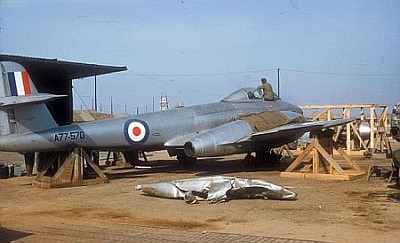 |
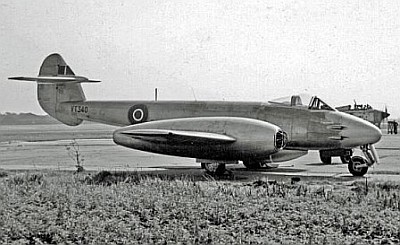 |
General Description:
• Crew: 1
• Length: 13.59 metres (44.7 ft)
• Wingspan: 11.32 metres (37.2 ft)
• height: 3.96 metres (13 ft)
• Wing Area: 32.52 square metres (350 square ft)
• Performance: 965 km/hr (600 mph 522 knots) mac 0.82 at 3050 metres (10,000 ft)
• Range: 965 km (600 miles)
• Service ceiling: 13,1000 metres (43,000ft)
• Time to altitude: 5.0 minutes to 9,145 metres (30,000ft)
Shamus O'Farrell had knowledge of the Meteor as he mentioned it in the 1991 book, stating that the Meteor and the Sea Fury were fastest military aircraft in Australia at the time. This jet fighter most probably were not the aircraft that O'Farrell observed. He most probably would have recognised it as he was familiar with this particular aircraft. By 1954 the Meteor was nearing its use-by date and was retired to training and secondary duties in 1955. I feel comfortable eliminating the Meteor from the contenders.
de Havilland Vampire:
In 1946 the RAAF was given approval to purchase fifty Vampire fighter aircraft. The first Vampire F.30 fighter made its flight in June 1949. The Vampire Trainer production in Australia amounted to 110 aircraft for the RAAF in 1952 and the Royal Australian Navy ordering five in 1954. The RAAF Vampires were in service until 1970 and the RAN craft were retired in 1971.
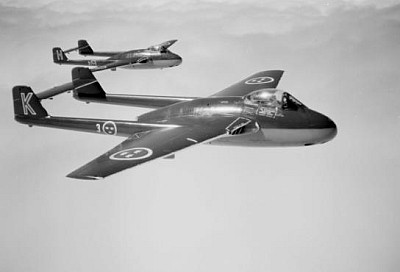 |
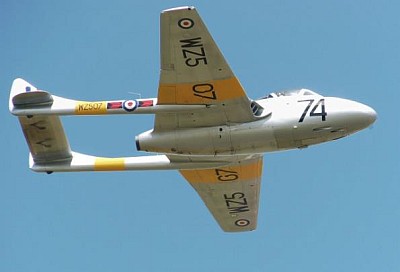 |
General Description:
• Crew: 1
• Length 9.37 metres (30.9ft)
• Wingspan: 11.58 metres (38ft)
• Height: 2.69 metres ( 8.10 ft)
• Wing area: 24.34 square. metres (262 square ft)
• Maximum speed: 882 km/hr (548mph)
• Range: 1,960km/hr (1,220 miles)
• Service ceiling: 13,045 metres (42,000ft)
• Rate of climb: 4,800 ft/min (24.4 m/s)
The Vampire made its first flight in 1949 in Australia and was in service by the RAAF in 1952 and the RAN took delivery of 5 Vampires in 1954, so they would have been known to O'Farrell. For that reason I will eliminate the Vampire.
Hawker P. 1081
In 1949 the RAAF began assessing replacements for the two fighters built in Australia, the Mustang and the Vampire. Hawker Aircraft submitted the proposal for a swept wing, swept tail jet fighter based on the Hawker P.1052. Work began to modify the P.1052. The modified and engineered P.1081 took to the air for the first time on 19, June 1950. By mid-1950 the RAAF urgently needed a replacement for the Mustangs that were in combat in Korea with the possibility of clashes with the superior MiG 15s. The RAAF realised that the Hawker P. 1801 could not realistically be operational within the time frame required. In November 1950 Hawker decided to cease development. Instead the RAAF ordered the readymade Gloster Meteor. The P. 1081 prototype which had remained in the U.K was handed over to the Royal Aircraft Establishment. Its swept tail design increased the Mach number above that of the P. 1052 into Mach 0.9-0.95 providing valuable data that contributed to the design of the Hawker Hunter. On 3, April 1951 the only prototype P.1082 was lost with the death of its pilot.
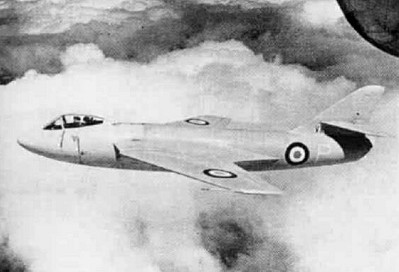 |
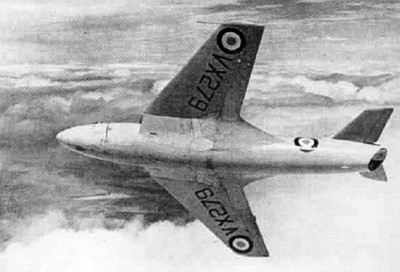 |
General Description:
• Crew: 1
• Length: 11.38 metres (37.4 ft)
• Wingspan: 9.6 metres (31.6 ft)
• Height: 3.30 metres (10.10 ft)
• Wing area: 23.97 square metres (258 square ft)
• Maximum speed: 1,119km/hr (604 knots)
• Service ceiling: 13,900 metres (45,600ft).
The Hawker P. 1082 would have been a real candidate for the mysterious aircraft as it would have been the fastest jet fighter in Australia, getting very close to breaking the speed of sound. But there was only one prototype built and it crashed in 1951. So, the P. 1082 must be eliminated as a possible candidate.
de Havilland Sea Venom:
The de Havilland Sea Venom was a British post war aircraft carrier jet fighter. It had its first flight in April 19, 1951. The Sea Venom saw service with the Australian Navy replacing the Sea Fury in 1956 and during its service operated off the aircraft carrier HMAS Melbourne.
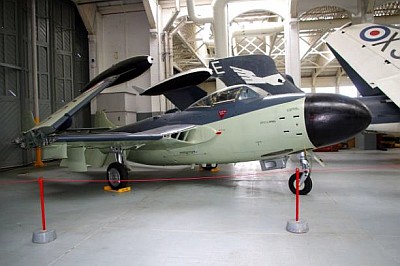 |
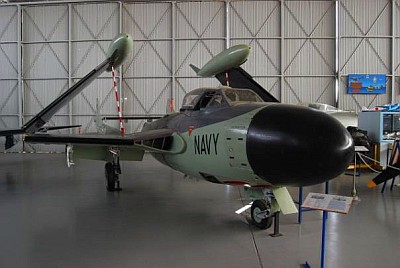 |
General Specifications:
• Crew: 2
• Length: 11.15 metres. (36.7 ft)
• Wingspan: 13.06 metres (42.10ft)
• Height: 2.6 metres (8.6ft)
• Wing area: 29.9 square metres (279.8 square ft)
• Maximum speed: 927 km/hr (500 knots 575 mph)
• Range: 1,135 km (705 miles)
• Service ceiling: 12,040 metres (39,500ft)
• Rate of climb: 5,750 ft/per-min (29.2 m/s)
The Sea Venom had it first flight with the British Navy in 1951 but did not enter service with the Australian Navy until 1956. It's interesting to note that this particular jet fighter was the replacement for the aging Sea Fury and would have been flown by O'Farrell after the Sea Fury was retired. The Sea Venom must also be eliminated as it did not go into service until 1956. O'Farrell would have known about this particular jet fighter even during the testing phase as it was the replacement for the Sea Fury and was only used by the Australian Navy. When thinking about it, he wouldn't have been harassed by pilots from the Navy. So I can comfortably eliminate the Sea Venom.
CAC Sabre:
As I was eliminating the early jet fighters I was ready to admit defeat that previous researchers were right in saying that there were no aircraft at that time that had the capabilities of the aircraft that O'Farrell had described. But when I came upon the CAC Sabre jet fighter that changed. This jet fighter in theory could be a serious candidate for the two mystery aircraft. I will put forward my hypothesis to why this aircraft could be a candidate. Of course, this is based on available data on the Sabre, and following the available clues from the night of the incident. Of course, it can't be proven beyond reasonable doubt, but I think it is a plausible candidate.
The CAC CA-27 Sabre A94-901:
Background
In 1949, the RAAF began planning for a replacement jet fighter for the aging Mustang and the inferior DHA Vampire. There were a number of contenders including the Hawker P.1081. Due to the time constraints and the Korean War, the RAAF didn't have time to develop their own jetfighter in time, and opted to purchase the Gloster Meteor that was already in production in 1951. This would turn out to be an inferior jet fighter during combat in Korea with the Russian MiG-15 fighter.
In the same year plans were finalised for the Commonwealth Aircraft Corporation (CAC) to build a locally redesigned version of the North American F-86F Sabre swept wing jet fighter. The CAC Avon Sabre was based on the North American F86 Sabre but was modified extensively for Australian conditions and requirements. CAC won the contract to produce the prototype (A94-901) and seventy production aircraft in 1951. Due to the technical research initiated by CAC Manager, L.J. Wackett the RAAF decided to modify the Sabre making it a very different aircraft to its American cousin. The Australian modifications made a huge improvement over the American Sabre.
Improvements included:
• Installation of Rolls Royce Avon R.A.7 turbojet engine, later replaced with the Rolls Royce Mk26 Avon engine, giving substantially more power than its American cousins
• Increased diameter of the nose air intake to accommodate the larger engines
• Revised cockpit layout
• Heavier armament. Cannons instead of machine guns
• Increased fuel capacity
• Fitting of the Plessey isopropyl nitrate liquid fuel combustion starter, which allowed the aircraft to start without an external power source.
The resulting improvements, away from the North American blueprint, replacing the General Electric J47 jet engines with the Rolls Royce Avon R.A.7 turbo jet engines in theory was double the maximum thrust and double thrust-to-weight ratio of the J47 engine. With the new engines, it necessitated a redesign of the fuselage, as the Avon was shorter, wider and lighter that the J47. Over 60 percent of the fuselage was altered and there was a 25 percent increase in the size of the air intake.
The resulting improvements for the Avon-Sabre became the best of the numerous Sabre variants built in the world.
The prototype CAC CA-26 Sabre Mk 30 first flew in 3, August 1953 with the Avon engine, piloted by Flight Lt. Bill Scott. During a test flight of the Sabre at Avalon Airfield on 21 August 1953 took the jet fighter to a height of 12,800 metres (42,000ft) and put it into a dive and at 11,000 metres (36,000ft) exceeded the sound barrier (approximately 1042 km/hr) and becoming the first aircraft in Australia to exceed the speed of sound.
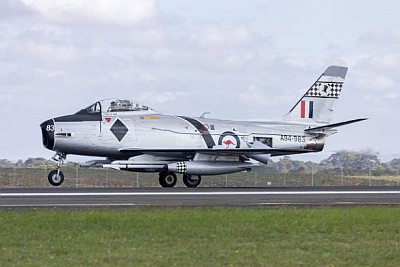 |
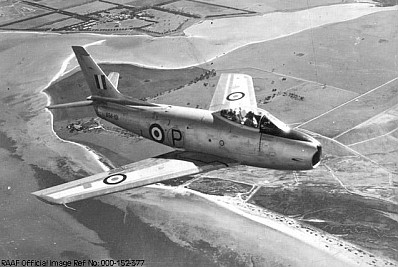 |
General Description:
• Crew: 1
• Length: 11.43 metres (37.6 ft)
• Wingspan: 11.3 metres (37.1 ft)
• Height: 4.39 metres (14.5 ft)
• Wing area: 28.1 square metres (302 square metres)
• Power plant: 1x rolls Royce Avon Turbo Jet.
• Maximum speed: 1,100 km/hr (700 mph 605 knots)
• Range: 1,850km (1,153 miles)
• Rate of climb: 12,000 ft/min at sea level (61m/s)
As can be seen the CAC Sabre was the most powerful and versatile Australian jet fighter to date. Heavily modified and re-engineered, making it a superior aircraft to the original North American Sabre. The Sabre jet fighter could easily carry out the manoeuvres and accelerate at the speeds that O'Farrell described. The prototype was able to break the sound barrier at approximately 1042 km/hr on its early test flights. This was one of the first of the modern supersonic jetfighters that had the capabilities that some said was not available at that time. It was an engineering achievement made by Australian know-how to combat the Cold War.
O'Farrell described the two aircraft in his original report as being able to make out a vague shape with the white light centrally on top, and in the 1991 book as two dark cigar shaped objects - not very long about the size of a Dakota but their central light made the outline quite distinct. In the Bill Chalker interviews, he described seeing a dark mass and that they were quite big but couldn't make out any other lights or any other form of an aircraft. In The OZ Files he described seeing a white light situated on top of a large shape, like the top of a football.
Although O'Farrell has slightly different variations over the past few decades the descriptions are roughly similar. The shape of the Sabre does fit in with his variety of descriptions, if the navigation lights were turned off it could look cigar or football shaped or a dark mass or the original vague shape. I believe it is plausible that the centrally mounted bright light was a form of camouflage.
The most difficult aspect of my hypothesis is proving that the Sabre Jet Fighters were in fact in the vicinity of O'Farrell's Sea Fury.
I believe there is enough circumstantial evidence to speculate on the timing and location of the mysterious aircraft. The clues can be found in O'Farrell's story itself and background research on the Sabre's development.
I found a newspaper article from the Sydney Morning Herald dated Friday 18 June 1954 that gives me my first clue, titled ‘First Australian - Built Sabre Jet Leaves Production Line for Flight Test Next Week’.
It reads, ‘The first Australian Sabre jet fighter to leave the regular production line of the Commonwealth Aircraft Corporation factory in Victoria has been taken to Avalon airfield near Geelong, where it will undergo test flights beginning next week. Shown above, inspecting the aircraft (left to right) Sir Ian Lawrence Wackett of C.A.C, the chief of executive of the C.S.I.R.O, Sir Ian Clunes Ross and Sir George Jones, also of the C.A.C. RIGHT: As engineer, Mr S. Curan, examines the Sabre's air intake into which an inspector was sucked on Wednesday. The inspector, Raymond Santos, 44, escaped serious injury.’
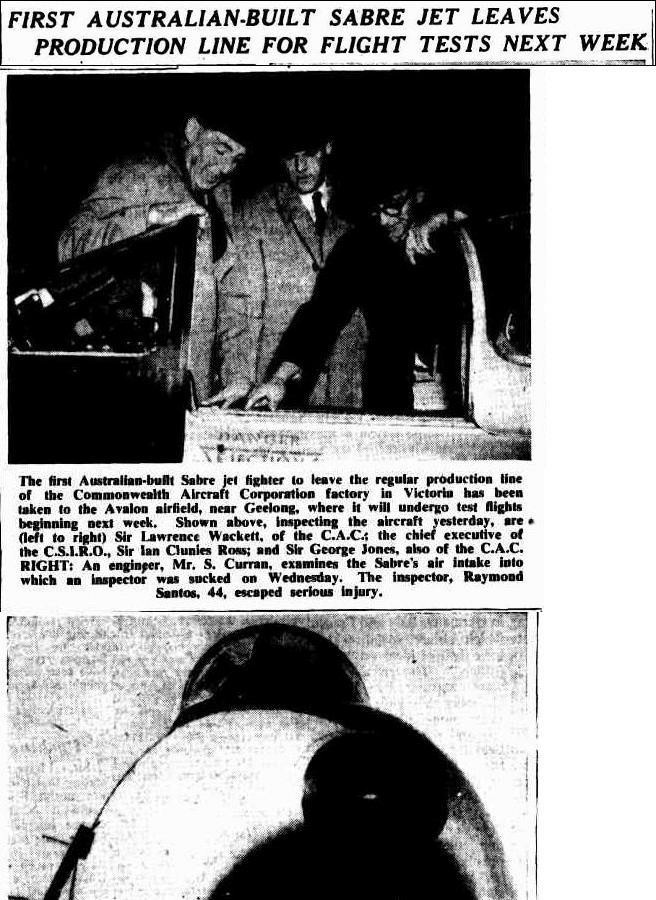
The newspaper article gives a very good clue as it tells us that the Australian built Sabre jet fighter was to leave the production line of the Commonwealth Aircraft Factory to commence test flights at the nearby Avalon airfield near Geelong in June 1954. This means the Sabre was airborne and being tested leading up to O'Farrell's incident. It was plausible that on the night of the O'Farrell incident that the Sabres could have been on a test flight from Avalon or Laverton airfield, Victoria.
I went on the Trove website in an attempt to find as much information on the Sabre jet fighter as possible, to follow its progress and to see if there were any clues that could assist my hypothesis that the Sabre jet fighters could be the mystery aircraft. I was surprised to find that the Australian media took a great interest in the Sabre's progress. This enabled me to follow its progress, where it was stationed and its moments during 1954.
According to the Daily Mercury, Monday 12 July, 1954, the first production line Sabre jet fighter for the RAAF was going to make its first test flight on the 13 July, 1954. To be piloted by Bill Scott from the Lara test field at Avalon near Geelong. This particular Avon Sabre was the second to be built in Australia. The first Sabre was test flown in 1953 was being kept by CAC as a prototype at Avalon.
The Morning Bulletin, Monday, 12 July, 1954 gives us a bit more information. It adds the testing on the second Sabre would be in about a fortnight. Then it was to be handed to the RAAF at a special ceremony at Laverton Research Unit in Victoria. They were to be the first to use it. The RAAF had ordered ninety Australian Sabres.
In the Newcastle Sun Friday 10, July 1954, it was reported that the Commanding Officer of No. 2 fighter Operational Training Unit at Williamtown (Wing Commander H.C Cresswell) said that the Australian built Sabre jets would be based at Williamtown in 1955 for operational trials and testing.
The Brisbane Telegraph. Tuesday 24, August 1954, told us that a third Sabre jet fighter has been sent to Avalon Airfield. On the following Monday, the RAAF would get its first Sabre at an official handover.
From these newspaper articles I know there were three Sabre Jet fighter based at Avalon Airfield. The original prototype and two freshly built Sabres being tested.
I also know that there was going to be a handover of the first production Sabre on Monday 30, August 1954, the day before the Sea Fury Incident.
I now know that a squadron of Sabres were going to be based at Williamtown by early 1955, the first one to arrive in December 1954.
My theory was still feasible, there were three flying Sabres at Avalon, two that were still being tested. They could have flown to Goulburn within 30 minutes. In principle, it is possible that the Sabre jet fighters could be the mystery aircraft, but one thing bothered me and that was when they sped away from O'Farrell they turned in a north-easterly direction before disappearing of the radar. Then they were reported over Marulan and then over Sydney still heading in a north-easterly direction. In theory if they were based at Avalon I thought they should have turned and headed back in a south-westerly direction back to Avalon in Victoria. That threw a spanner in my theory.
I went back to Trove website in an attempt finds more clues. I already knew that the Sabre jet fighters were going to be based at Williamtown by the end of 1954. That made me think, that the two aircraft were still travelling in a north-easterly direction as they passed Sydney Airport. If the two aircraft were to keep travelling in that direction they would end up in Williamtown (119km north of Sydney). This was the RAAF base where the first Sabre squadron was to be stationed. But the problem was that the first Sabres were not due to arrive until December that year.
As I was going through newspaper articles regarding the Sabre jetfighter and Williamtown Airbase I came across a very interesting newspaper article from the Newcastle Morning Herald dated Thursday, 2 September 1954. Only two days after the Sea Fury Incident. It reported that a special flight would be performed at the Williamtown aerodrome to test the RAAF's new Sabre jetfighter under operational conditions. The Air Force Week was from September 13-19 when the RAAF hoped to fly the Sabre jet fighter over the city in a special demonstration. The Sabre may be flown from Melbourne to give the demonstration.
This got me thinking, if they were going to fly a Sabre jet fighter from Avalon Airbase to Williamtown to do a demonstration flight for Air Force week in mid-September, would they do any practice or test runs before the big day. I did find a newspaper article from the Newcastle Morning Herald dated Friday 17 December, 1954 where it was reported that Top Wing Commander Cresswell flew the first of the Sabre fighter jets from Laverton (Vic) to Williamtown RAAF base in 53 minutes, beating the previous record for the trip, set by a Vampire jet that was 75 minutes. The pilot took the Sabre through the sound barrier. The pilot said he didn't hurry as it was a routine delivery flight, so there was no sense in going flat out. He flew at a height of 43,000ft. He went on to say it wasn't the best time, he could have clipped many more minutes off the record if the Sabre had been equipped with extra fuel tanks and ‘given her the gun’ . His average ground speed was 660 knots. Over Williamtown he climbed to 47,000ft before diving the Sabre at about 720 mph, faster than the speed of sound.
Reading this article; it was a routine flight, that could be done in 53 minutes or less if the aircraft was fitted with extra fuel tanks. Could it be possible on the night of the August 31 the Sabres were doing a practice run to Williamtown? If they had extra fuel tanks they would have been able to do a round trip in just under two hours. If not they would have had to refuel at Williamtown before returning. Reading the September 2 article there was no mention that the Sabre doing a flyover Newcastle was going to land at Williamtown. That would mean it would do the flyover demonstration before flying back to Melbourne. If that was correct the Sabre jet fighter would have long range tanks fitted to make the return journey.
I think it is plausible that the RAAF could have conducted test runs from Melbourne to Newcastle to ensure that the Sabre had the fuel range required and to make sure there were no mechanical issues as the demonstration flight was to show off the Sabre to the general public for the first time.
I also think it is plausible that if a test flight took place from Avalon or Laverton, to Williamtown, that it would take place at night as not to cause any attention to itself. I couldn't say why two jets would be used for such an exercise, but I believe it is plausible that if the test flights were done under the cover of night it is possible that the jets could have turned off their navigation lights, maybe using a single bright light to camouflage the jets identity. Reading the newspaper articles the Sabres were flown by highly experienced pilots who had flown the North American Sabres during the Korean War. This would mean that they were highly skilled pilots who were battle hardened.
I am speculating more than I should, but imagine highly experienced battle ready pilots flying at night, with all navigation lighting turned off with a single bright light camouflaging one of the world's fastest and most advanced jet fighters of its day. Maybe knowing that the radar system was not working in NSW on that night, they came upon a much slower aircraft in the distance. As O'Farrell said he thought that the two lights were playing chicken with him. Maybe the RAAF pilots recognised it was a Navy Plane and decided to have a bit of fun. Coming up from behind, slowing down to 220 knots and flying on either side of O'Farrell's Sea Fury, they would have been listening to O'Farrell's radio communications. But as soon as O'Farrell contacted Nowra and they confirmed that the two aircraft were on the radar, they would have realised that their cover had been broken. Taking off in a north-easterly direction at high speed between two to three times the speed of the Sea Fury, making the Sea Fury look as if it was standing still.
What I also find interesting is, that where O'Farrell had the encounter with the two aircraft near Goulburn NSW, that this was within the flight plan for aircraft today if they were travelling from Laverton/Avalon Victoria, to Williamtown.
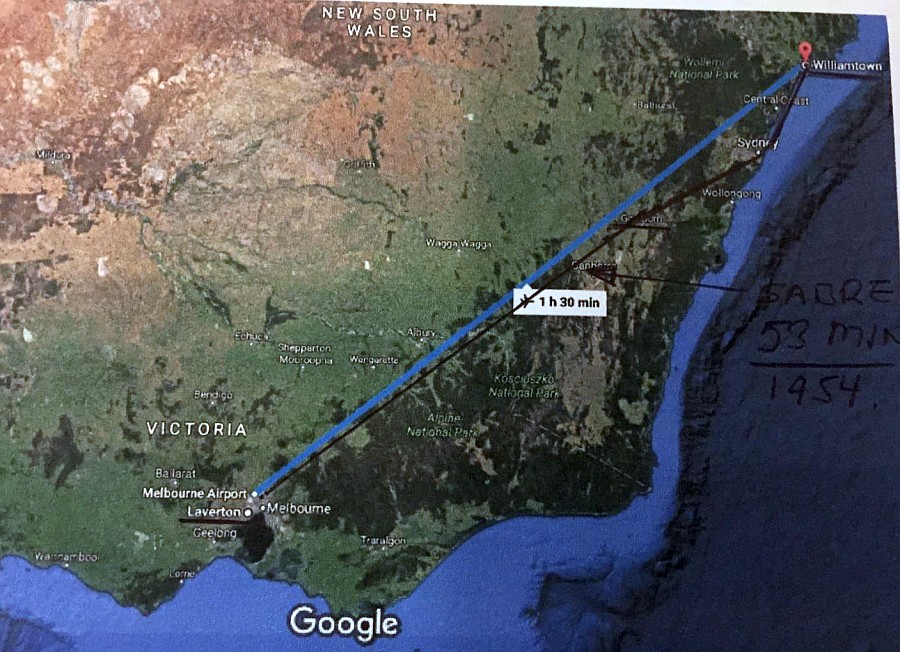
Map of Eastern Australia. Blue line is the standard route taken by aircraft today, travelling from Laverton/Avalon Victoria to Williamtown. Black thin line represents the possible route the two mystery aircraft may have taken on the night of O'Farrell's encounter if they had taken off from Laverton/Avalon Victoria to the Goulburn area were the incident took place, then turning north-easterly, heading over Marulan, passing by Sydney airport in the direction of Williamtown. If the aircraft had enough fuel they may have taken the blue line route back to Avalon/Laverton
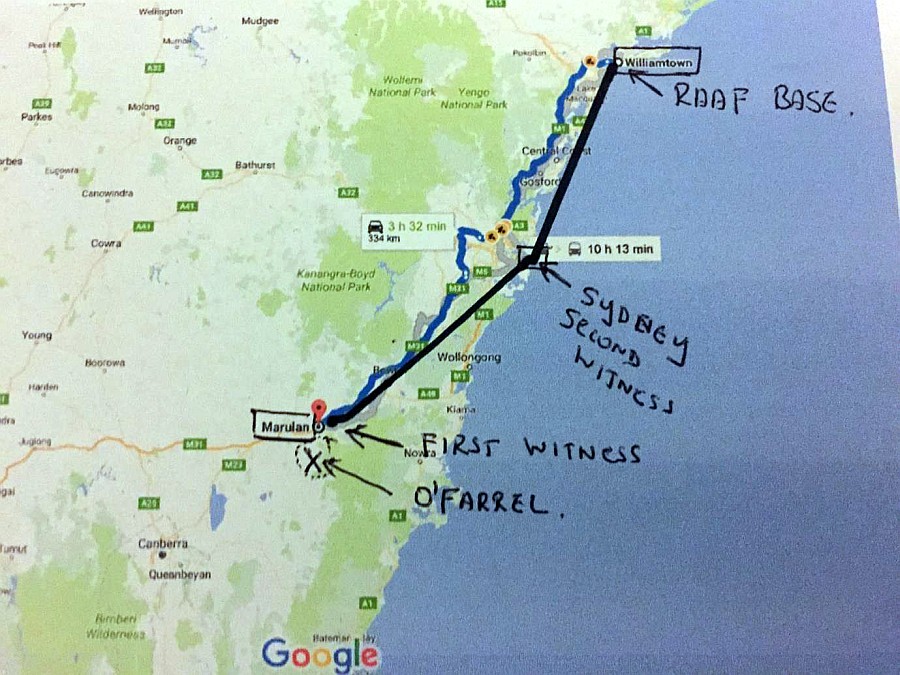
Map of NSW showing the direction that the two aircraft took after speeding away from O'Farrell in a north-easterly direction. I have added the plausible direction that they may have taken if heading towards Williamtown.
I believe my hypothesis, in theory, is plausible. I also know there are numerous unresolved issues. One being that the RAAF denied having any aircraft in the air that night. I can't answer that except to say the mystery aircraft acted, flew and manoeuvred like a military aircraft. And the only aircraft that was being tested at that time in the Eastern States and had the capabilities as described by O'Farrell could have been the CAC Sabre jet fighter. My thoughts on why the RAAF may have denied any of their aircraft were in the air that night could be to cover up the antics of the test pilots who may have been flying in a reckless manner, having a bit of fun with a rival from the Navy.
I still think it is plausible that they may behaved in such a manner because they thought the radar was still inoperable as O'Farrell described it during the early part of the flight. I do believe if the radar system was still inoperable during the encounter with the two aircraft that O'Farrell would have never reported it and the incident would never have been made public.
Although if my theory was on the right track, there would have been consequences for the test pilots with a secret, behind closed doors enquiry by the RAAF. The flying saucer story would have been a convenient cover for the actions of the responsible pilots.
I also believe that the missing JIB files that had surfaced in 1973 would have been censored with only information relating to what O'Farrell needed to know. I doubt that any sensitive or classified material would have been included, otherwise O'Farrell would have revealed this in his later interviews or the incident would no longer be the mystery it is today.
Taking an educated guess, if the Sabres jet fighters were involved, it would have been a separate investigation by the RAAF that would be unlikely shared with the Navy. Meaning that there would be no information shared with the Navy exposing the Sabres or there could have been some type an agreement between the RAAF and Navy to keep it classified.
If there were files relating to the Sabre jet fighters and the Sea Fury they most probably would be under the RAAF umbrella, hidden away amongst thousands of other files and that's assuming that they haven't been destroyed or lost. Again, taking an educated guess, maybe they could be hidden amongst files concerning:
• Avalon airfield
• Laverton RAAF
• Williamtown RAAF base
• Aircraft Research and Development Unit RAAF
• Sabre jet fighters
• Aircraft testing
• Department of Defence
• NAA files.
The key to this case would be finding any files that could relate back to the Sea Fury incident but I feel there is still a long journey ahead to find the true nature to this fascinating cold case.
Section 7 - Conclusion
As with any cold case there is rarely a definitive conclusion, and the Sea Fury Radar incident is no exception. I have taken a serious look at the case in an attempt to put forward a possible explanation. My hypotheses, I believe, is plausible with the data that I could find on the case, mainly from the interviews by O'Farrell, newspaper articles and the Navy Files that Keith Basterfield was able to find. I was disappointed with the material that was available from civilian researchers as most have just copied and pasted Bill Chalker's interviews with Shamus O'Farrell on the internet. The only researcher who asked the important questions since the 1990's was Keith Basterfield in his 2012 blog. His material gave me the motivation to have a closer look at this cold case.
Of course my hypothesis is only one possible explanation for this mystery. But I don't see any extra-terrestrial intervention in this cold case. The common phrase used was, ‘there were no aircraft available in Australia with the capabilities that O'Farrell described.’ On this matter, I believe I have proven that there was an aircraft with the capabilities that O'Farrell reported. The CAC took an impressive North American jet fighter and turned it into one of the most powerful long range jet fighters in the Western world.
In a newspaper article, (Sydney Sun, Thursday 20 August 1953) it reports:
MELBOURNE: Thursday - The sonic boom of Australia's Avon-Sabre jet fighter crashing the sound barrier will be heard tomorrow by Prime Minister Menzies. Test Pilot Lt. W.H Scott, RAAF, will set the plane in a screaming dive through the barrier in its first ‘official’ flight. The demonstration will be watched by Mr. Menzies, Defence Production Minister Harrison and Commonwealth Aircraft Corporation chairman Leonard Darling. The jet is rated the most powerful long-range fighter in the Western world. It has already flown at above 600mph in level flight at high altitude. Sound speed is 660mph. The Sabre can climb vertically at a speed that takes it out of sight in a few seconds. It has been flown at an altitude of 9 miles and ‘packs a terrific punch’ in armament.
This description I believe covers all the capabilities described in the Sea Fury incident. One has to remember that O'Farrell was only doing a modest 220 knots at the time of the incident. At no time did he attempt to speed away, challenge, or attempt to contact the two mystery aircraft.
To finish off, I must admit that this cold case is as real as a UFO cold case can be. What was reported was roughly what took place and the mysterious aircraft were tracked on radar and witnessed by the pilot involved in real time. In essence these two mystery aircraft were UFO's as they were Unidentified Flying Objects. But the evidence available indicates that they were terrestrial in nature and most likely belonging to the RAAF.
The only way this cold case will truly be solved is for all the military files to be found if they exist as this will give us insight to what really happened. This will be no easy task and I would go as far to say near impossible.
But for some, having an unexplained mystery will keep the UFO aspect of the story well and truly alive.
References:
• Australian Disclosure Project: The Sea Fury Incident.
http://australiandisclosureproject.blogspot.com.au/2006/04/sea-fury-incident-date-august-31-1954.html
• Australian UFO Researcher, Bill Chalker. The Sea Fury Incident.
http://www.auforn.com/Bill_Chalker_30.htm
• UFOs at close sight: August 31, 1954 Nowra, Australia by James E. McDonald.
http://ufologie.patrickgross.org/htm/nowra54mcd.htm
• Project 1947: UFOs Sub Rosa Down Under. The Australian Military & Government Role in the UFO Controversy by Bill Chalker. PART 2 ‘Sea Fury Incident’
http://project1947.com/forum/bcoz2.htm#fury
• Unidentified Aerial Phenomena - Scientific Research: Fact Matter - the 1954 Goulburn, radar/visual event Parts 1 & 2 by Keith Basterfield.
http://ufos-scientificresearch.blogspot.com.au/2012/11/facts-matter-1954-goulburn-radarvisual.html
http://ufos-scientificresearch.blogspot.com.au/2012/11/facts-matter-1954-goulburn-radarvisual_28.html
• Trans-Australia Airlines Museum: TAA Convair Aircraft. www.taamuseum.org.au/TAAaircraft/aircraft_convair
• Historical Aircraft Restoration Society: CAC CA-27Sabre. www.hars.org.au/cac-ca-27-sabre • Wikipedia: Hawker P.1081. wwwwikipedia.org/wiki/hawker_P.1081
• Wikipedia: Hawker Sea Fury: www.wikipedia.org/wiki/hawker_sea_fury
• Wikipedia: CAC Sabre. www.wikipedia.org/wiki/CAC_Sabre
• Wikipedia: de Havilland Sea Venom: www.wikipedia.org/wili/De_Havilland_Sea_Venom
• Wikipedia: Gloster Meteor: www.wikipedia.org/wiki/Gloster_Meteor
• Wikipedia: Convair CV -240 Family: www.wikipedia.org/wiki?Convair_CV-240_Family
• Wikipedia: No. 2 Operational Conversion Unit RAAF. www.wikipedia.org/wiki/
No_2_Operational_Conversion_Unit_RAAF
• Wikipedia: Temora, NSW: www.wikipedia.org/wiki/Temora_New_South_Wales
• Wikipedia: Goulburn, NSW: www.wikipedia.org/wiki/Goulburn_New_South_Wales
• Wikipedia: Young, NSW: www.wikipedia.org/wiki/Young_New_South_Wales
• Wikipedia: Yass, NSW: www.wikipedia.org/wiki/Yass_New_South_Wales
• Wikipedia: Cowra, NSW: www.wikipedia.org/wiki/Yass_New_South_Wales
• Wikipedia: Marulan, NSW: www.wikipedia.org/wiki/Marulan_New_South_Wales
• Wikipedia: HMAS Albatross (Air station): www.wikipedia.org/wiki/HMAS_Albatross_(air_station)
• Wikipedia: Sydney Airport: www.wikipedia.org/wiki/Sydney_Airport.
• Wikipedia: HMAS Albatross (1928). www.wikipedia.org/wiki/HMAS_Albatross_(1928)
• Wikipedia: Aircraft Research and Development Unit RAAF. www.wikipedia.org/wiki/Aircraft_Research_and_Development
• Wikipedia: RAAF Base Williamtown. www.wikipedia.org/wiki/RAAF_Base_Williamtown
• Argus (Melbourne, Vic), Thursday 16 December 1954, page 1
http://nla.gov.au/nla.news-article23443013
• Newcastle Morning Herald and Miners. Monday 13 December 1954, page 1.
www.trove.nla.gov.au/newspaper/rendition/nla.news-article134096131.3
• Morning Bulletin, Rockhampton, QLD: Monday 12 July 1954, page 4.
wwwtrove.nla.gov.au/newspaper/rendition/nla.news-article57332094.3
• Daily Mercury (Mackay QLD) Monday, 12 July 1954.
www.trove.nla.gov.au/newspaper/rendition/nla.news-article169413879.3
• Newcastle Morning Herald and Miners. NSW: Monday December 13, 1954.
www.trove.nla.gov.au/newspaper/rendition/nla.news-article134096131
• Sun (Sydney, NSW) Thursday 20, August 1954.
www.trove.nla.gov.au/newspaper/rendition/nla.news-article230218003
• Newcastle Sun. NSW. Friday 10 July 1953.
www.trove.nla.gov.au/newspaper/rendition/nla.news-article16141868
• Brisbane Telegraph QLD. Tuesday 24 August 1954.
www.trove.nla.gov.au/newspaper/rendition/nla.news-article217225156.3
• Newcastle Morning Herald and Miners Advocate. NSW. Friday 17 December 1954.
www.trove.nla.gov.au/newspaper/rendition/nla.news-article130487890
• Newcastle Sun. NSW. Tuesday 14 December 1954.
www.trove.nla.gov.au/newspaper/rendition/nla.news-article16333965
• Newcastle Morning Herald and Miners' Advocate. NSW. Thursday 2 September 1954.
www.trove.nla.gov.au/newspaper/rendition/nla.news-article134088137
• Mercury (Hobart Tas.) Wednesday 26, May 1954, page 28.
www.trove.nla.gov.au/newspaper/rendition/nla.news-article27231545
• Courier Mail (Brisbane, QLD) Monday 12 July 1954 page 5.
www.trove.nla.gov.au/newspaper/rendition/nlanews-article50597964.3
• Sydney Morning Herald. NSW. Friday 18 June 1954, page 1.
www.trove.nla.gov.au/newspaper/rendition/nla.news-article18438765.3
• Sun (Sydney, NSW) Wednesday 16 April 1954, page 13.
www.trove.nla.gov.au/newspaper/rendition/nla.news-article230704807
• Google maps: Williamtown to Marulan NSW.
www.google.com.au/maps/dir/Williamtown,+New+South+Wales/Marulan,+New+South+Wales
• Google Maps: Laverton Vic, Australia to Williamtown: www.google.com/maps/dir/laverton,+VictoriaAustralia/Williamtown,+New+South+Wales231
• National Archives of Australia (NAA) file series MP926/1 control system 3079/101/1 'titles ‘Identified objects (flying saucers sighted by navy pilot over Goulburn)
• National Archives of Australia: NAA file series SP338/3 control 13/4/10 titled ‘Unidentified objects (flying - reports of).
Veteran Australian UFO researcher and author Bill Chalker provides some contrasting commentary on the Sea Fury incident article above at his The OZ Files Blog.
|
| ||||
|
|
| |||